When Eric Bandholz couldn’t grow a beard at his corporate bank job, he quit and built a men’s grooming company.
Today, that company, Beardbrand, is a household name, pulling in over $100k in MRR.
I recently spent a month reverse-engineering Beardbrand’s entire marketing funnel, from top to bottom…
And today, I want to share with you 13 strategies you can use to grow your online store … even if you don’t have a big marketing budget.
Sound good?
Let’s get to it.

Beardbrand Marketing: Use These 13 Tactics to Grow Your Online Store
Below are 13 strategies Beardbrand use to grow its reach, get loyal customers, and drive more revenue. They won’t all be relevant to you. That’s a given. So, to save time, I’ve added a table of contents so you can jump to the strategies that interest you most.
1. Redefine a Common Misconception About Your Buyer Persona
2. Open a Curiosity Gap at Checkout to Turn Prospects into Repeat Customers
3. Create Content Around Top-of-Funnel Middle-of-Funnel, and Bottom-of-Funnel Search Queries
4. Increase Your Organic Footprint with YouTube Videos
5. Use “The Marketer Magnet Method” (With a Twist)
6. Use “Meta-Branding” to Build Do-Follow Links
7. Repurpose Design Assets on Authority Sites
8. Promote Popular Content with Facebook Ads
9. Answer Frequently Asked Questions to Overcome Objections
10. Improve Your Facebook Carousel Ads with This Little-Known Testimonial Hack
11. Turn Prospects into Customers with a Drip Email Course
Part 1. Positioning
“Positioning is not what you do to a product,” writes Al Ries and Jack Trout in their book, Positioning. “[Positioning is] how you differentiate yourself in the mind of your prospect.”
So, how is Beardbrand winning the battle for their buyers’ attention? Let’s take a look to see what they’re doing to rise above the noise in an already crowded industry…
Strategy #1: Redefine a Common Misconception About Your Buyer Persona
American men are NOT shaving like they used to.
It’s true.
According to a recent consumer report, the era of beards is causing problems for razor companies, with sales falling by 5.1% over the last year alone.
“Today, men are not judged negatively when they skip a shave, Massimiliano Menozzi, the vice president of Gillette North America, told Nathaniel Meyersohn in a recent interview. “It is not considered lazy or disrespectful.”
But it’s not always been like this.
Years ago, skipping a daily shave was considered taboo—unthinkable, even particularly in the workplace.
Beardbrand co-founder, Eric Bandholz, knew this feeling better than anyone.
Having worked in corporate America, Bandholz, a beardsman himself, had experienced his share of ridicule from co-workers and society in general.
“At work, I would get mocked for having a beard,” he said in an interview with Oscar Raymundo. “They’d ask me things like, ‘forgot to shave?’”
Realizing the corporate lifestyle wasn’t for him, Bandholtz left, and after a series of events, found his calling … to change the way society view beardsmen and to foster confidence through grooming.
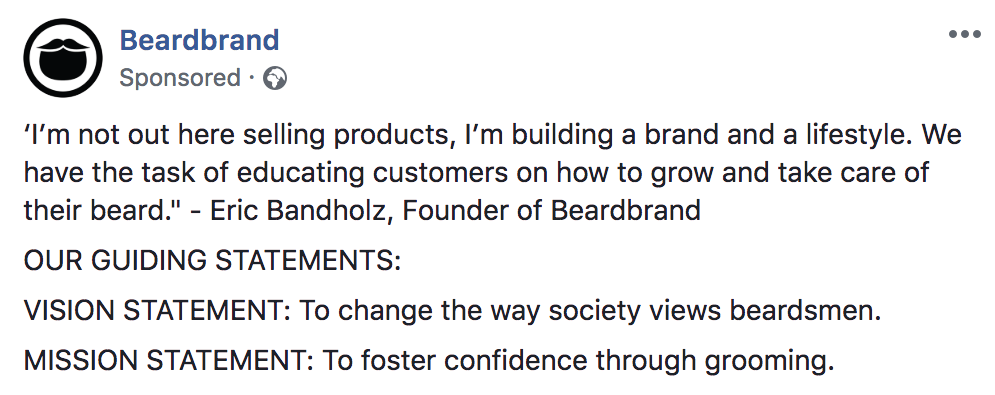
“Before Beardbrand, beardsmen were typically stereotyped as lumberjacks, bikers, or outdoorsmen,” writes Bandholz. “Even though these are awesome beardsmen, I got really tired of the ZZ Top, Duck Dynasty, and Grizzly Adams references. I knew that there were guys out there who wore a beard but didn’t fit those traditional stereotypes.” (Bold added for emphasis.)
Much like how Casper reinvented its target market’s buying experience, Beardbrand redefined its buyer.
They built assurance into their marketing, a reminder that it’s okay to grow a beard—even if you don’t identify with the above stereotypes. You can have it your way.
“I wanted to unite these groups of guys and show the world that you can be stylish, professional, be a normal dude, and have a beard,” says Bandholz. “At the time, that was a very foreign concept, so I established Beardbrand as a way to unite Urban Beardsmen and give them the tools they needed to feel confident about their beards.”
It’s important to mention here that redefining a buyer is about more than selling products or services; it’s about selling a community, a place where your target market feel they can belong, and contribute to, even. (More on that in Bonus Strategy #2).
Granted, it’s NOT easy. But if you can help your buyers feel good about their buying decision AND feel good about themselves when doing so, they WILL remember you for it. And that’s only a good thing.
Action item. Ask yourself, “Can I reinvent my buyer?” “How can I change what it means to buy my products and services?” “Is it possible to assure my buyers that they’re not alone?”
Strategy #2: Open a Curiosity Gap at Checkout to Turn Prospects into Repeat Customers
“Marketing is not a battle of products, it’s a battle of perception,” writes Al Ries and Jack Trout in The 22 Immutable Laws of Marketing.
And it’s true.
Today, consumers google search terms like, “buy beard oil” and feel overwhelmed with choices.
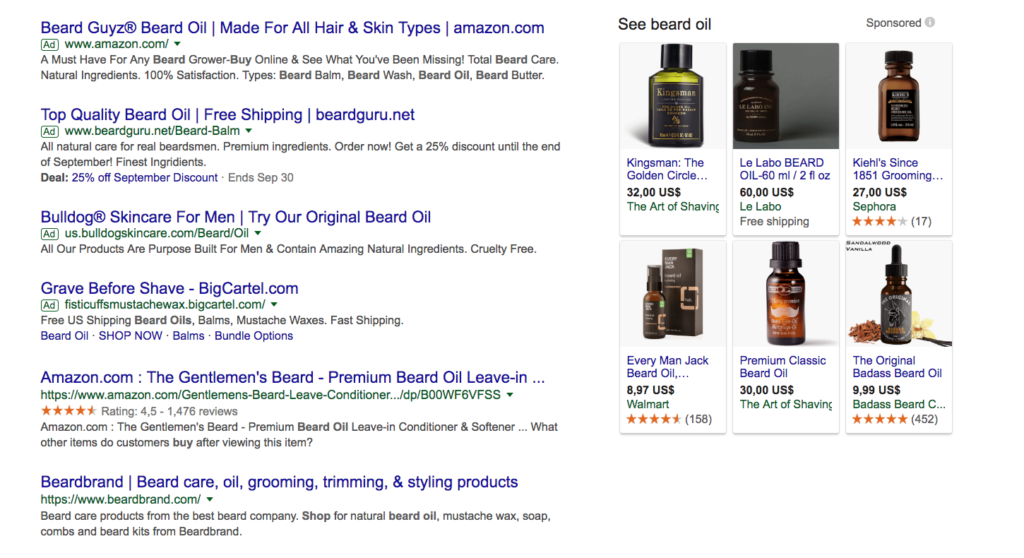
Beardbrand knows that. They understand that it’s not about being better— it’s about being first. That’s how you win the battle for the buyer’s attention.
So, how do you do that?
By creating defining moments, short experiences that are both memorable and meaningful. [Source.]
One of my favorite moments while researching Beardbrand was when I went through their checkout.
Like any profitable online store, Beardbrand knows the importance of upselling.
After all, it’s a great way to increase your customer’s average order value (AOV).

But what’s even better than upselling a product is upselling a subscription.
Why?
Because turning buyers into repeat buyers is one of the best ways of building predictable and repeatable revenue.
Beardbrand knows it’s likely happy buyers will return to buy again, so they have an “auto-restock” option on all their product pages.
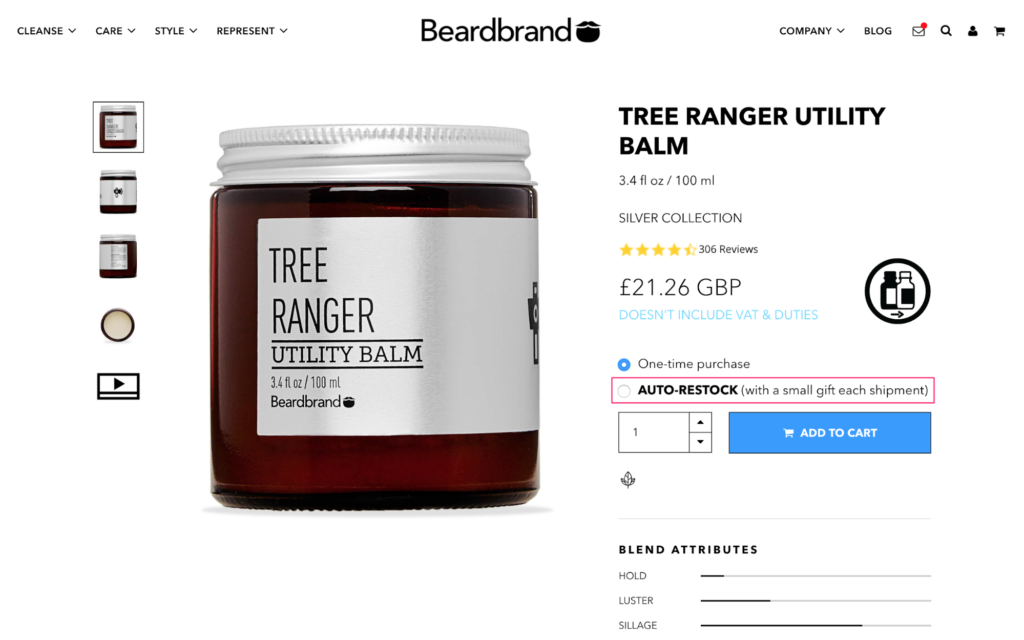
Nothing new there.
That is, until you look closer:

They offer a “small gift” to anyone that upgrades to a monthly subscription.
Think about that for a moment.
Beardbrand knows the importance of continuity (more on that in Bonus Strategy #2). But they also know their competitors are likely offering it, too.
So, to differentiate themselves, they offer an unnamed gift as a way of opening a curiosity gap.
And it’s genius.
Curiosity gaps are highly-effective, especially on pricing pages. In fact, in one experiment, Joanna Wiebe lifted conversions for a pricing page by 927%.
Moments are the key to victory in the battle for the buyer’s mind. Make ‘em count.
Action item. Open a curiosity gap at the checkout by offering a “small gift” to turn prospects into repeat buyers.
Part 2. Content Marketing
Many brands inevitably turn to content marketing as a way to get more customers.
But not Beardbrand.
Unlike their competitors that built a blog on the back of an existing brand, Beardbrand created content first, and then, as demand rose, began selling products.
And it all started with an overlooked Reddit post.
On February 12th, 2012, Bandholz publicly declared his intention to build a community for what he called the “Urban Beardsman” (a term that, perhaps even Bandholz, at the time, didn’t realize would one day become a household name).
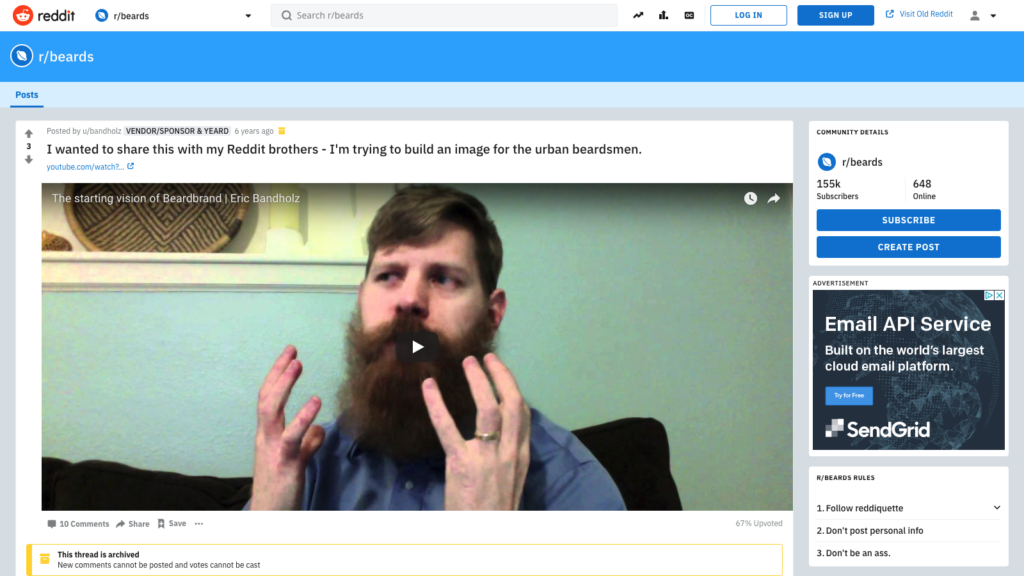
After building a community of around 300 members comprising mostly blog readers and YouTube subscribers, The New York Times reached out to Bandholz for a quote on an article about beards.

A day before the article went live, Bandholz and his co-founders launched an online store selling another brand’s products. As Bandholz said in an interview with Noah Kagan, “We used [the New York Times article] to leverage the launch of our company.”
Today, that online store that Bandholz “threw up” one afternoon generates an estimated 570,000 visitors a month. [Source.]
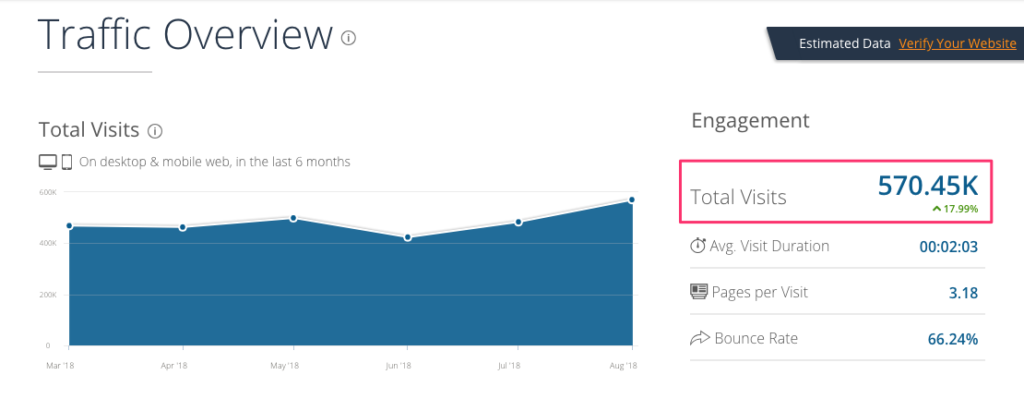
While it’s easy to assume much of Beardbrand’s traffic comes from PR, it doesn’t: it comes from content. Beardbrand, after all, by their own admission, aren’t just in the men’s grooming business; they’re in the education business.
“We were one of the first companies to make a beard oil and invest heavily into educating the market,” explains Bandholz. “This helped us stand out and grow organically.”
And indeed, it did.
According to SimilarWeb, 86.95% of all their social traffic (18.93% of their total traffic) comes from YouTube alone. (More on that in a moment.)
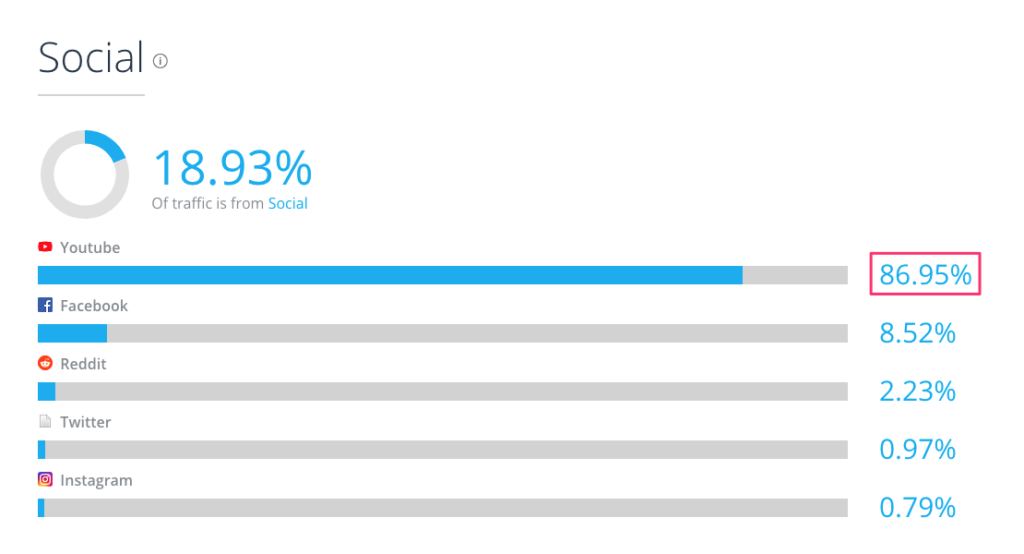
Moreover, as of writing, their YouTube channel has 879,558 followers and got 7,723,036 views in the last 30 days alone. [Source.]

So, now that we know where Beardbrand gets their organic traffic from (organic and social), let’s look at how they use it to rank for commercial keywords, build do-follow links, and more.
Strategy #3: Create Content Around Top-of-Funnel Middle-of-Funnel, and Bottom-of-Funnel Search Queries
If you invest in content marketing, it’s likely you’re familiar with content mapping.
If you’re not, content mapping involves delivering the right content to the right prospects at the right time.
Put another way, it involves targeting specific search queries depending on where a prospect is in the buyer’s journey.
Beardbrand hasn’t just mastered content mapping for their brand; they’ve monetized it.
Here’s how it works.
i. Top-of-Funnel (ToFu)
ToFu visitors come from informational, how-to queries.
For example, if you’re in Beardbrand’s target market, you might search for “how to grow a beard.”
And if you do, you will see Beardbrand ranking #2 for that term.

And it’s not hard to see why.
At 7,906 words, it’s an outstanding article.
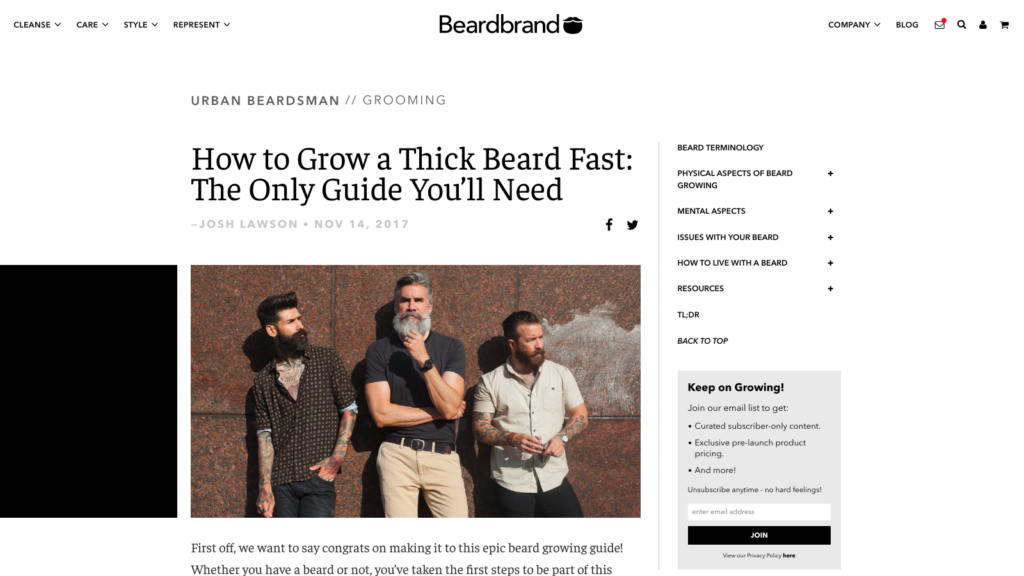
But it also ranks for 3,329 keywords, meaning it ranks for similar keywords like “how to grow facial hair” and “what makes a beard grow.”

While their goal isn’t likely to convert these visitors into customers, a percentage will (1) make a purchase on a whim, (2) enter Beardbrand’s Facebook and Google/YouTube retargeting flow, or (3) join Beardbrand’s email list and buy later. (More on that in Part 5.)
ii. Middle-of-Funnel (MoFu)
If you’ve ever included the word “coupon” or “discount” or something similar in a search query, it’s likely you were in the middle of a company’s funnel.
Let’s return to our earlier example. If, after reading Beardbrand’s article, you learned that maintaining a beard involves using oil or balm, you might search for something like “best beard oil and balm.”
And if you do, you’ll likely see a post explaining the difference between beard oils and balms.
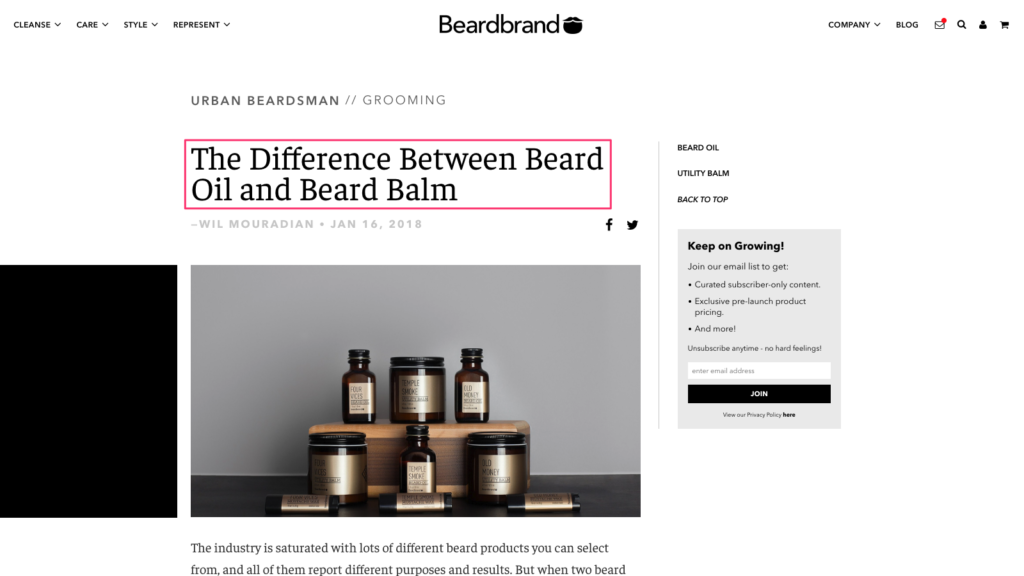
Within that article are small calls-to-action (CTAs) to buy Beardbrand’s products.
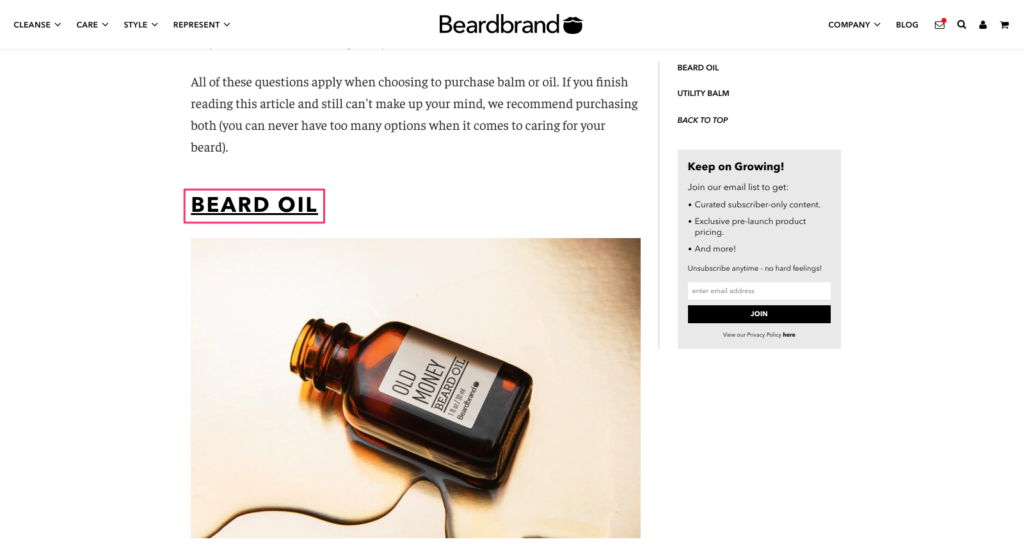
Much like ToFu visitors, not everyone will buy, of course. But that’s not the goal—Beardbrand is creating omnipotence in the men’s grooming space. And they’re hard to ignore.
iii. Bottom-of-Funnel (BoFu)
So, you’ve decided:
You need to buy beard oil or balm for your new beard.
But which is better?
You search for, “buy beard oil online,” and who do you see?
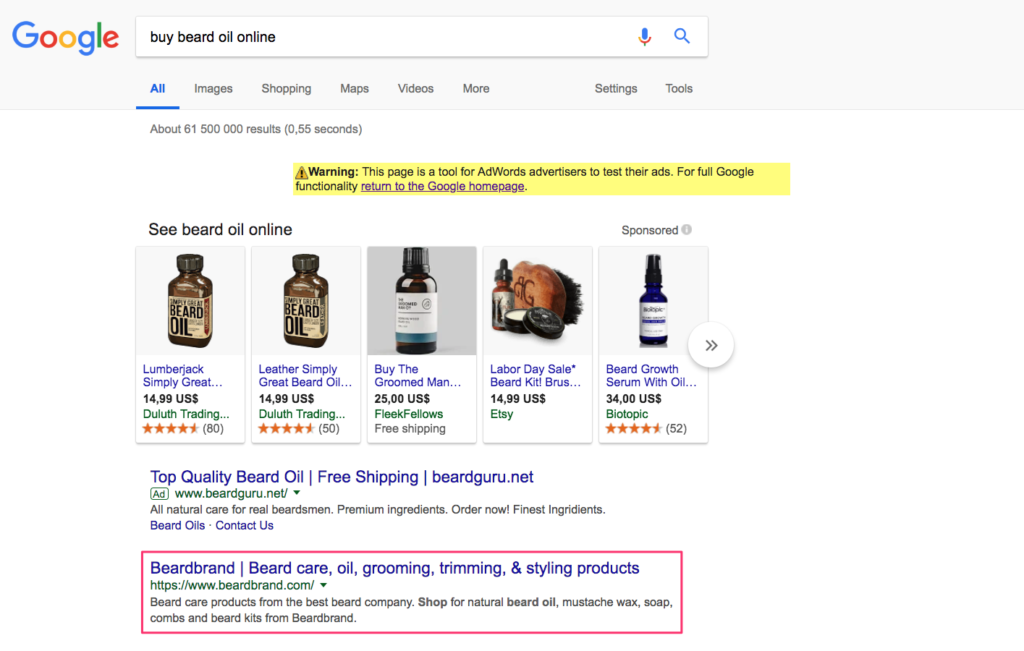
The brand that has educated you at each stage of your learning.
Aside from “buy beard oil online,” Beardbrand also ranks for several other commercial intent keywords like “beard oil buy online” and “where to buy beard balm.”
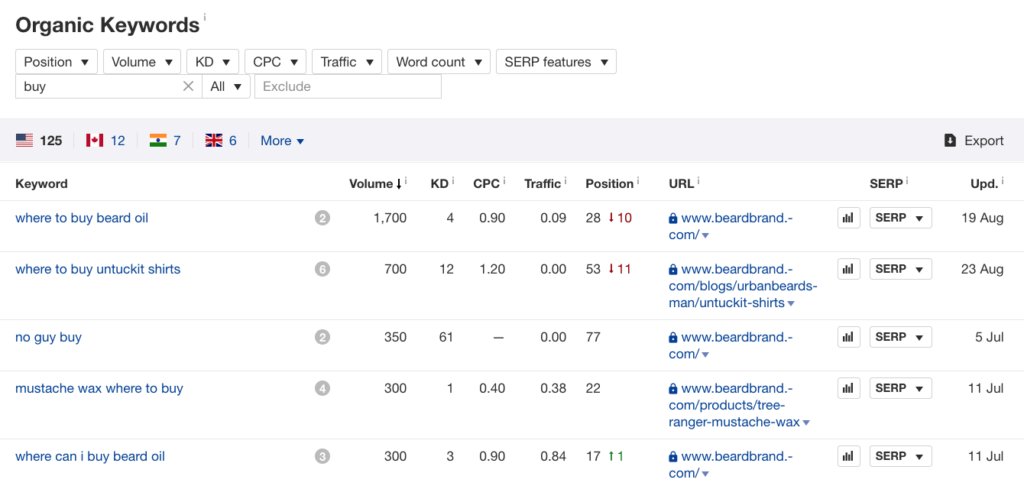
Best of all, because they rank organically, they don’t have to invest in Google Ads, meaning higher earnings for each sale.
Action item. If you’re investing in content marketing, create content that answers your buyer personas’ search queries at each stage of your funnel.
Strategy #4: Increase Your Organic Footprint with YouTube Videos
As mentioned above, Beardbrand’s primary marketing channel is video.
Specifically, YouTube.
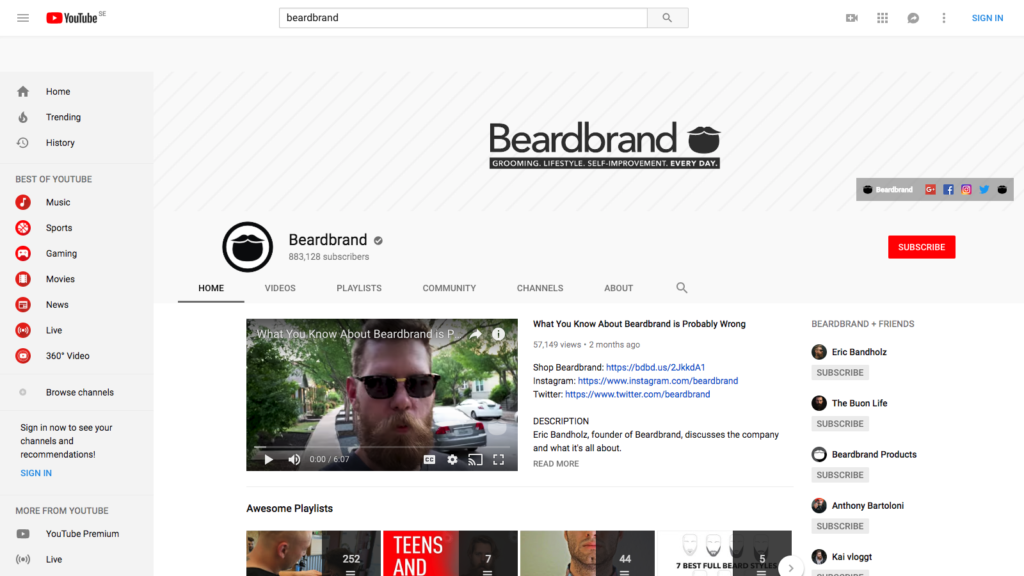
Beardbrand is a prolific publisher, too, posting one video a day on average.
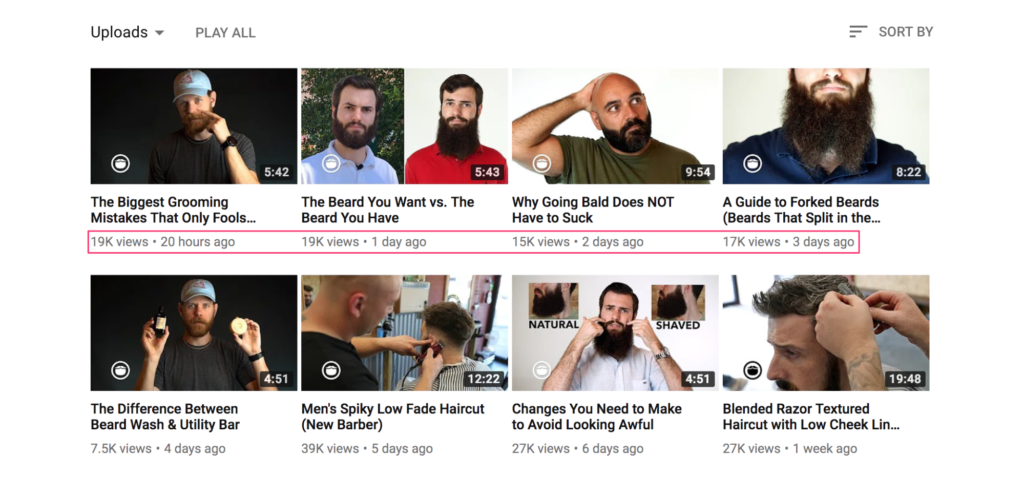
Of course, you could write an entire article alone on how Beardbrand uses YouTube to grow its audience. So, let’s take a closer look at two specific strategies they’re using to grow their audience.
i. Focus on “How-To” Content
If you read the previous strategy, you know that Beardbrand maps content for each stage of their funnel.
And video is no exception.
Much of Beardbrand’s videos focus on answering questions prospects have about growing and maintaining a beard.

But there’s another reason why they do this. And it’s easy to overlook…
Beardbrand embeds its videos in its content.
Adding video to content is a great way to boost dwell time—and that’s only a good thing for ranking higher in the search engine results pages (SERPs.)
You can see this in action below, in one of their more popular posts: “Beard Grooming Tips: How to Maintain an Awesome-Looking Beard”:
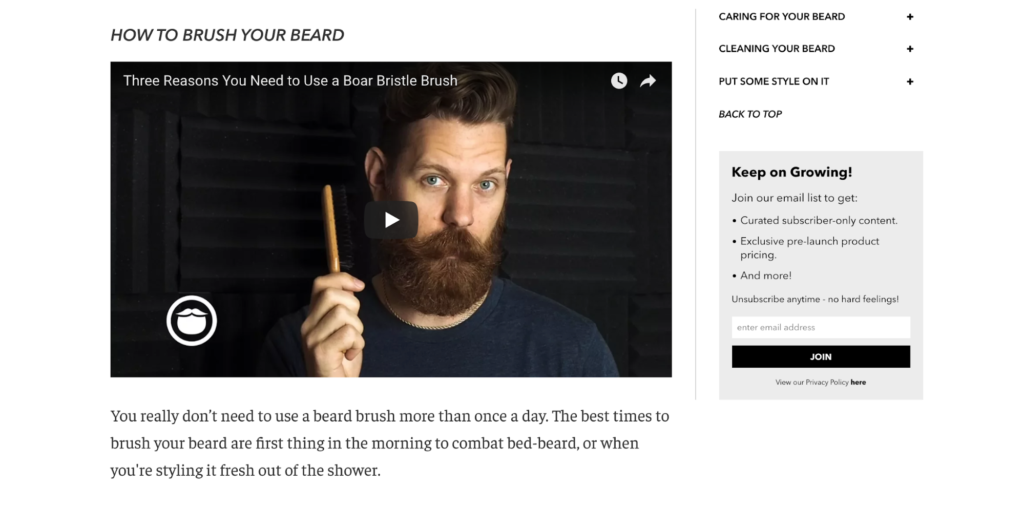
(Note: there’s something else going on here, but we’ll come to that in the next strategy.)
Best of all, because Beardbrand creates content on their site AND on YouTube, they’re able to dominate the SERPs for certain keywords.
For instance, they rank one blog post and two videos for the keyword “how to maintain a beard.”
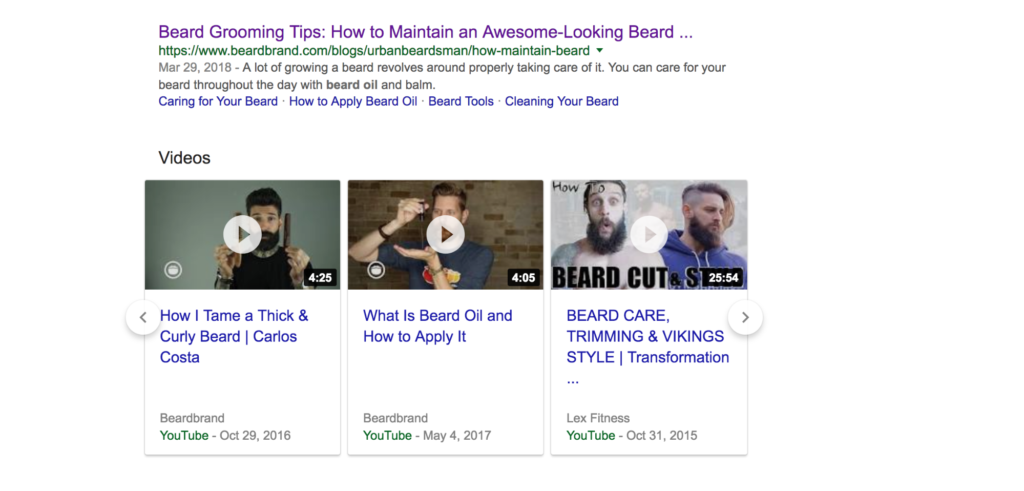
Not a bad way to get more traffic, huh?
ii. Track All Referral Traffic
Beardbrand is meticulous with tracking how they drive traffic to their site.
In fact, each video has a shortened URL in the video description, which links to a relevant product mentioned in the video.

If you click on one of their links, you can see their tracking down to the video the user came from.

Tracking referral traffic is an effective strategy because it informs you of whether it’s worth promoting on other channels like paid. Plus, you get data on which videos drive revenue—giving you more insight into what content to create in the future. (More on that in Strategy 8: Promote Popular Content with Facebook Ads.)
Action item. Create video content for your best-selling products. Then, repurpose those videos on your site where relevant. Lastly, track all referral traffic—and then double down on what works.
Part 3. Link Building
As of writing, Beardbrand has 51,919 backlinks from 1,440 referring domains.

Granted, many come from PR. But we’re not going to focus on that; you know I only want to show you what you can replicate.
So, here are three unconventional ways Beardbrand builds links and how you can, too.
Strategy #5: Use “The Marketer Magnet Method” (With a Twist)
If you’ve read our post on Harry’s marketing, you know one of my favorite link-building strategies is what I call “The Marketer Magnet Method.”
Simply put, it involves doing marketing that’s so unique other marketing blogs can’t help but write about you.
Often, it’s a link to a post referencing a strategy you’re using. Or, in other cases, it’s a screenshot within the post itself. Here’s a nice DR:90 do-follow link we got from Neil Patel recently, linking to an image from this post.
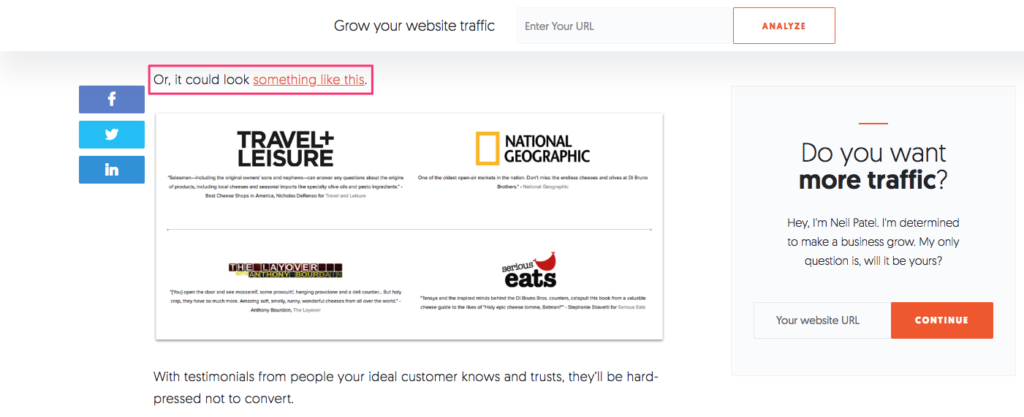
But there’s another level, one that I didn’t explain in that post.
Doing marketing that’s so unique that another sites write an entire post about it.
(Yes, kind of like what I’m doing now. Pretty meta, huh?)
If you’ve ever visited Bearbrand’s site, you might have noticed the quiz above the fold. (More on that in Bonus Strategy #1.)
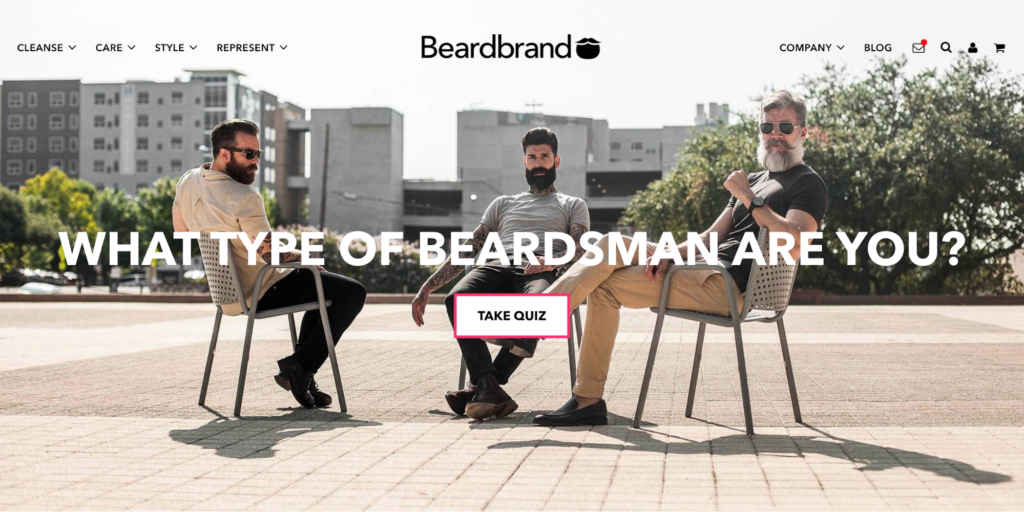
It’s a great lead-generation strategy in and of itself. And with 150,000+ email addresses so far, it works. [Source.]
But surveying visitors go beyond good list-building strategies.
Having used Typeform for the survey, the Barcelona-based startup interviewed Bandholz for an article breaking down their entire strategy.
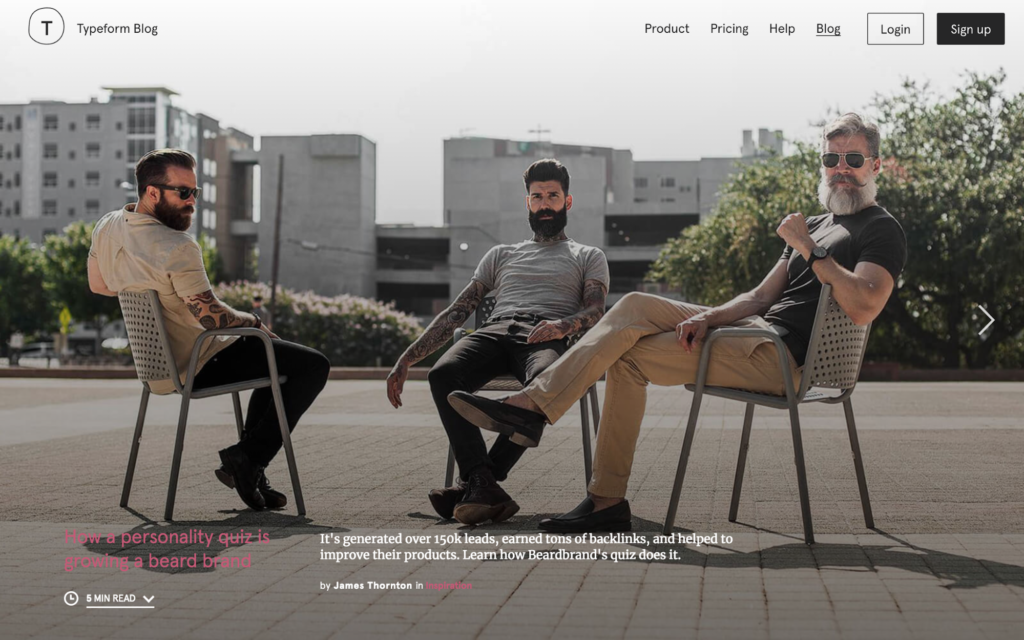
The best part? They got a nice DR:91 do-follow link back to their site.
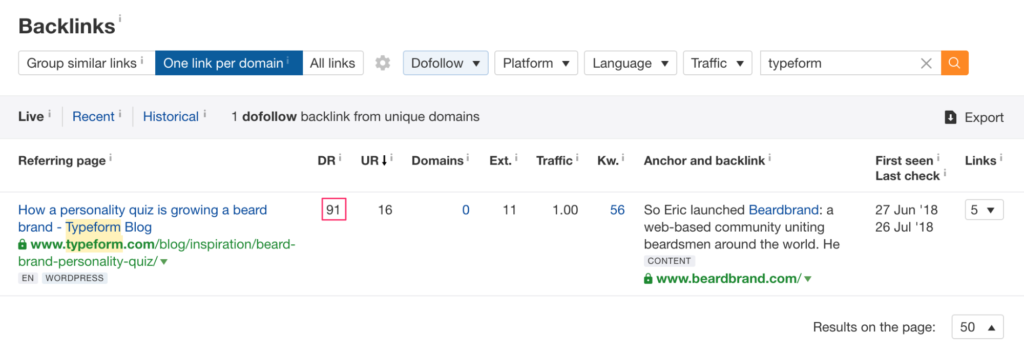
Action item. Good marketing attracts marketers. And links. But good marketing that’s done on the back of another brand’s product or service is even better.
Brainstorm the products or services you use to market your brand. Then, reach out, offering a testimonial. Or, even better, pitch a blog post outlining how you use their product or service and how others can, too. (Nat Eliason recently did this well in this post.)
Strategy #6: Use “Meta-Branding” to Build Do-Follow Links
In the above strategy, we looked at how doing good marketing attracts links.
And it makes sense.
Your brand does something interesting, and another site links to you for doing so.
But what about when you do something interesting? (Yes, YOU! The founder, employee, and individual).
One thing Beardbrand is amazing at is building their company around interesting individuals with existing personal brands.
I call this “meta-branding.” You’re not just building buzz through what your company’s doing; you’re getting attention through what YOU are doing as well, on an individual level.
But meta-branding goes beyond giving a quote or an interview. It also includes giving others a reason to share your story, as Shopify does in the below article:

As co-founder and spokesperson, Bandholz is front and center for much of Beardbrand’s media spotlight.
But it’s not just Bandholz that’s the source of good links.
For instance, in one article, Creative Mornings interviewed Beardbrand’s content strategist Marque Blackman on his morning routine.
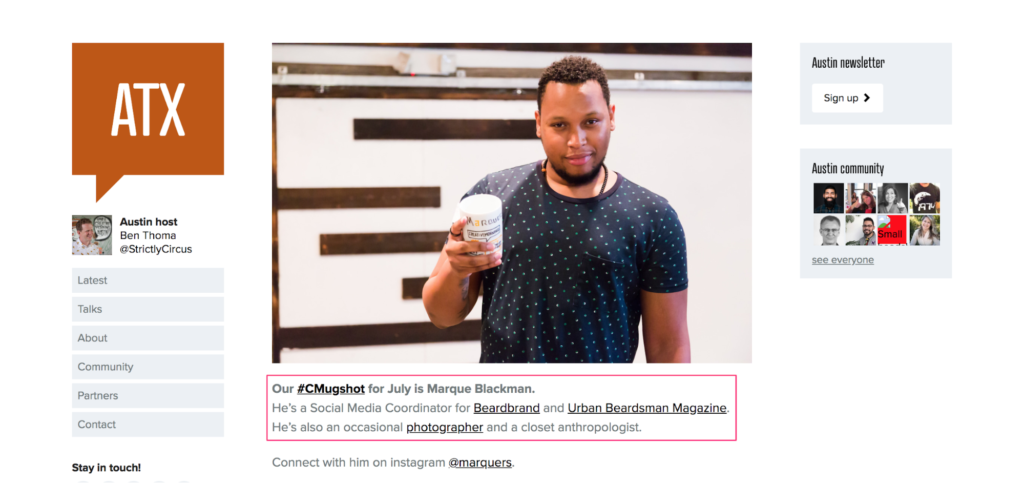
And Wolverine featured a guest post from Beardbrand writer Jeremy Lahman:
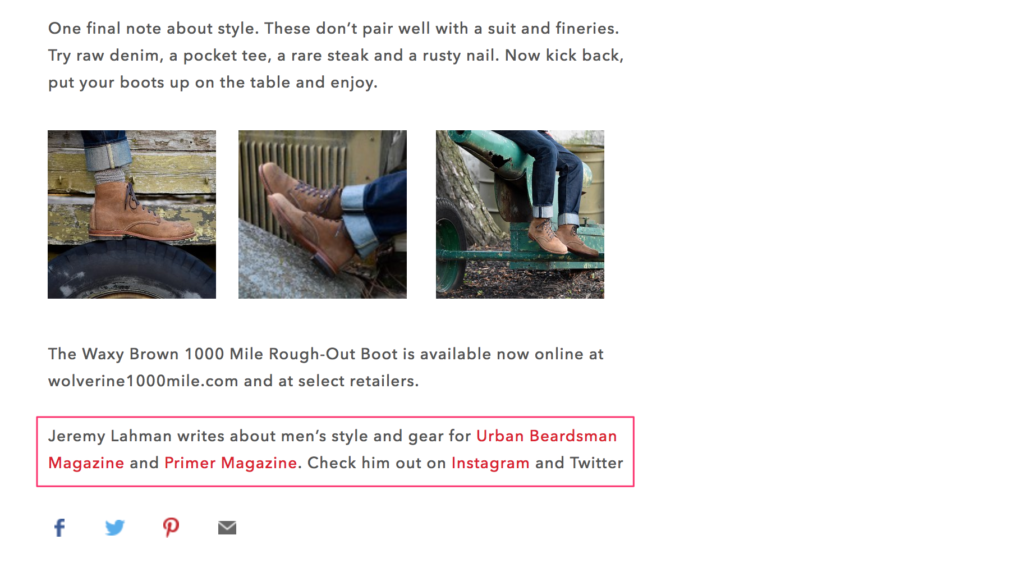
While it’s unrelated to link building, it’s also worth noting that Beardbrand employees are building their personal brands on YouTube, too.
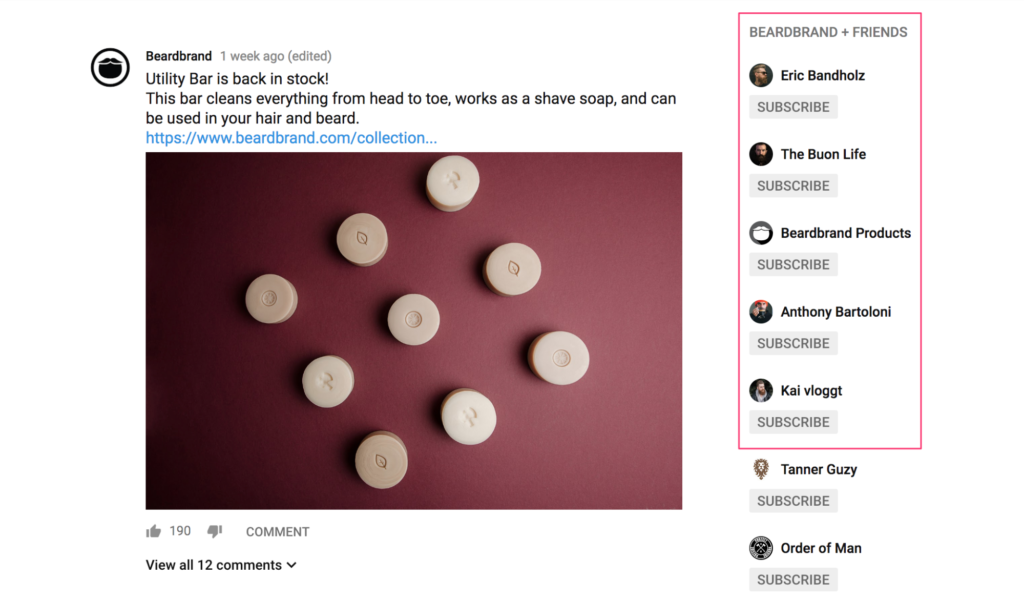
As their employees’ reach grows, so, too, does Beardbrand’s. Win. Win.
Action item. Hire people that aren’t only good at what they do but are sought out for their expertise. It reflects well on your brand, and it’s a great way to build links.
Strategy #7: Repurpose Design Assets on Authority Sites
If you’re investing in content marketing, it’s likely you’re familiar with content repurposing.
If you’re not, it involves taking a content asset, like a blog post, and using it elsewhere.
But it’s not limited to content.
Take product photography, for instance.
You invest in professional-looking photos for your products and ads to promote them. So, why not reuse them to build links?
This is exactly what Beardbrand does, though it’s so subtle it’s easy to miss.
Here’s a great example.
A few years ago, Beardbrand collaborated with award-winning designer Tobias van Schneider to create a limited-edition product called Black Marble. (Now unavailable.)
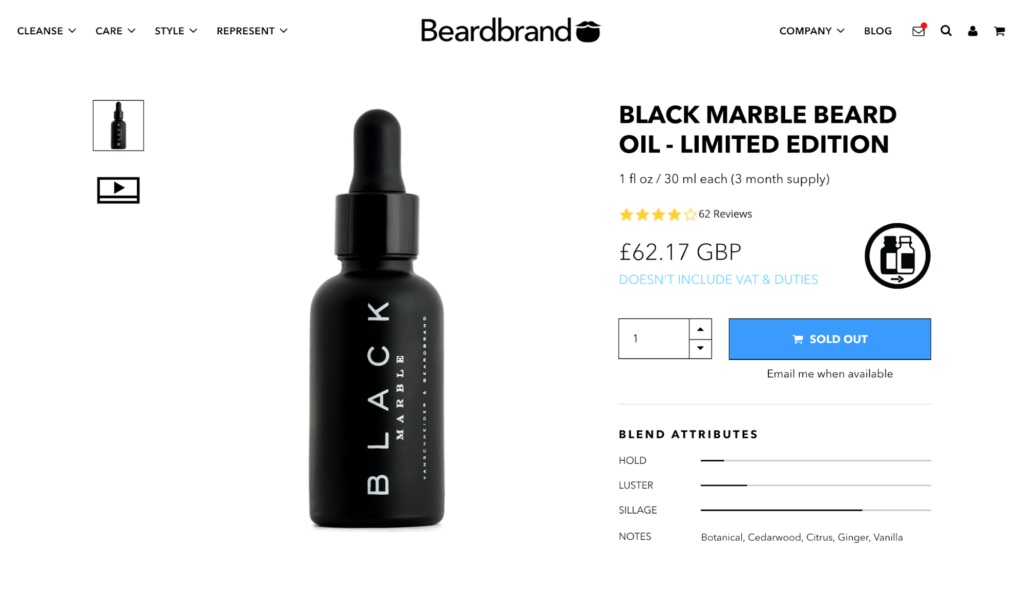
Van Schneider is building a brand of his own, so it’s no surprise that he shared the project on the online portfolio site Behance.
But here’s where it gets interesting…
There’s nowhere to add links when you add a design, even though Behance’s links are do-follow. But there’s one place you can add it.
Within the image itself.
When you look further at Van Schneider’s submission, you can see an embedded link back to Beardbrand’s home page.
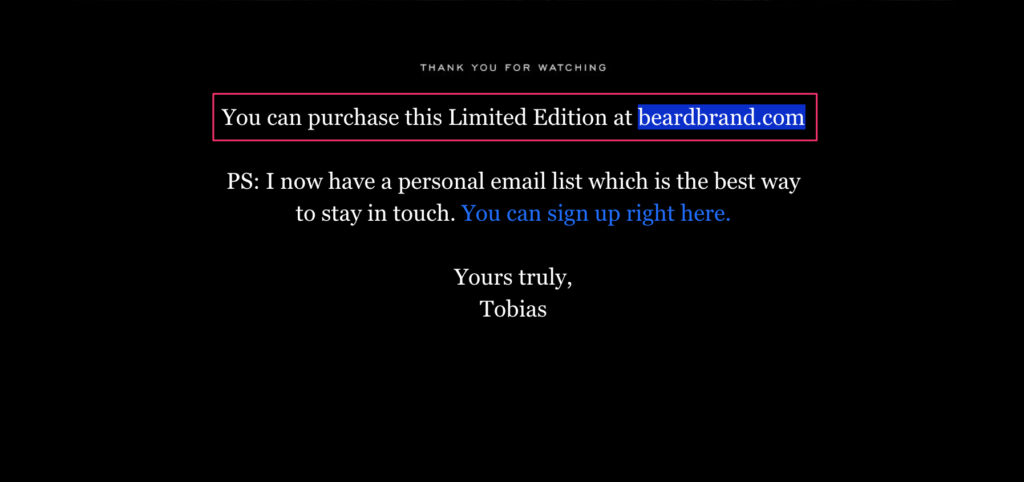
Not a bad way to get a link from a site with a DR:93 rating, huh?
Best of all, if other sites share that image or even link to that page, Beardbrand benefits from it. In fact, here’s a nice second-tier link from Abduzeedo (DR: 78)
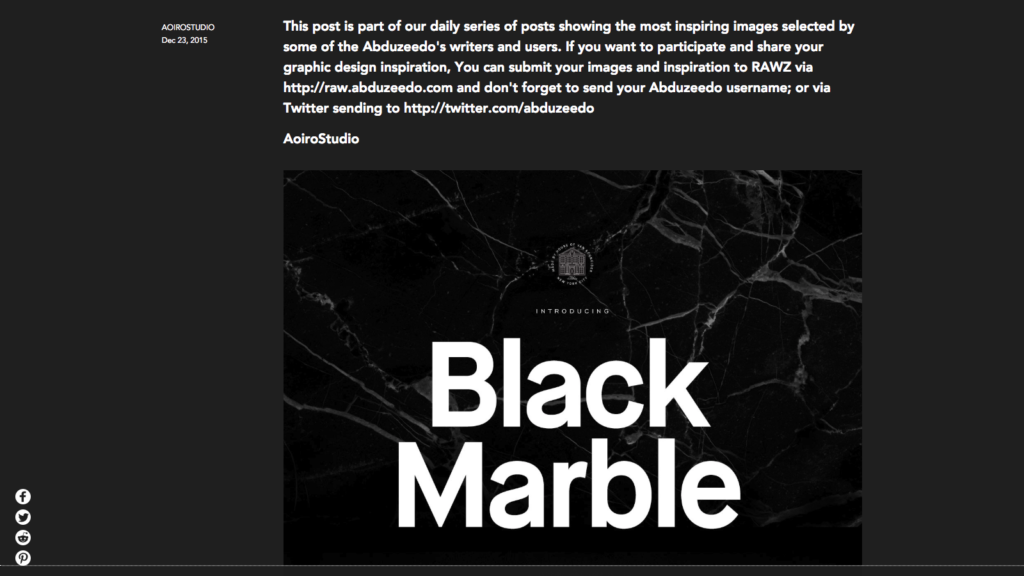
Genius.
Action item. Add a link to your homepage within relevant design assets. Then, repurpose those design assets by submitting them to online portfolio sites.
Part 4. Paid Acquisition
Content marketing works.
And for Beardbrand, it works VERY well. We know that much.
But what about paid advertising?
While it’s impossible to know how much Beardbrand invests in ads, we can get a general overview of the keywords they’re bidding on by diving into Ahrefs.
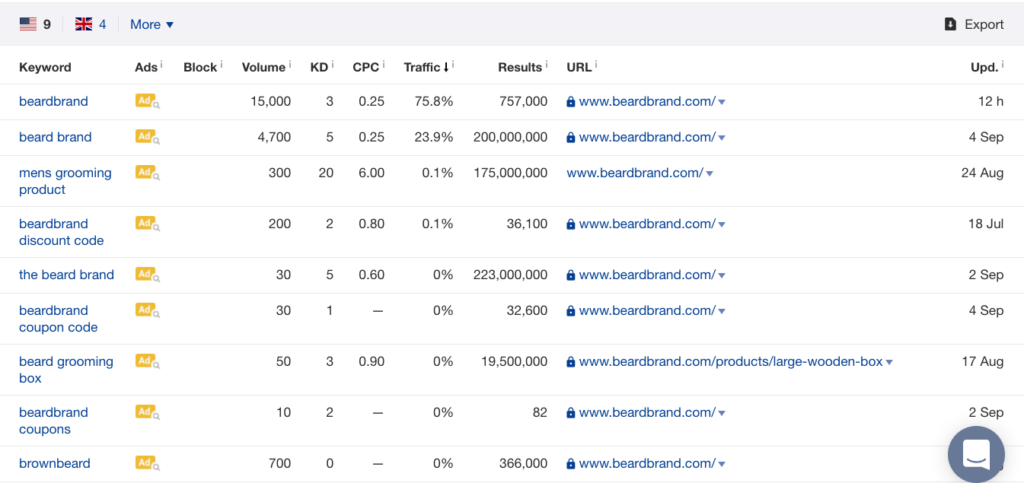
Facebook, meanwhile, is a platform they ARE active on. And they are nailing it.
Here’s how…
Strategy #8: Promote Popular Content with Facebook Ads
If you read Part 2, you know that Beardbrand is killing it with its content marketing strategy.
They’re getting a TON of organic traffic, and they’re converting a percentage of that traffic into customers.
So, it’s no surprise that Beardbrand is driving traffic to their most popular content using Facebook ads.
Here’s a recent example promoting “Jeff’s Top 5 Beard Secrets.”
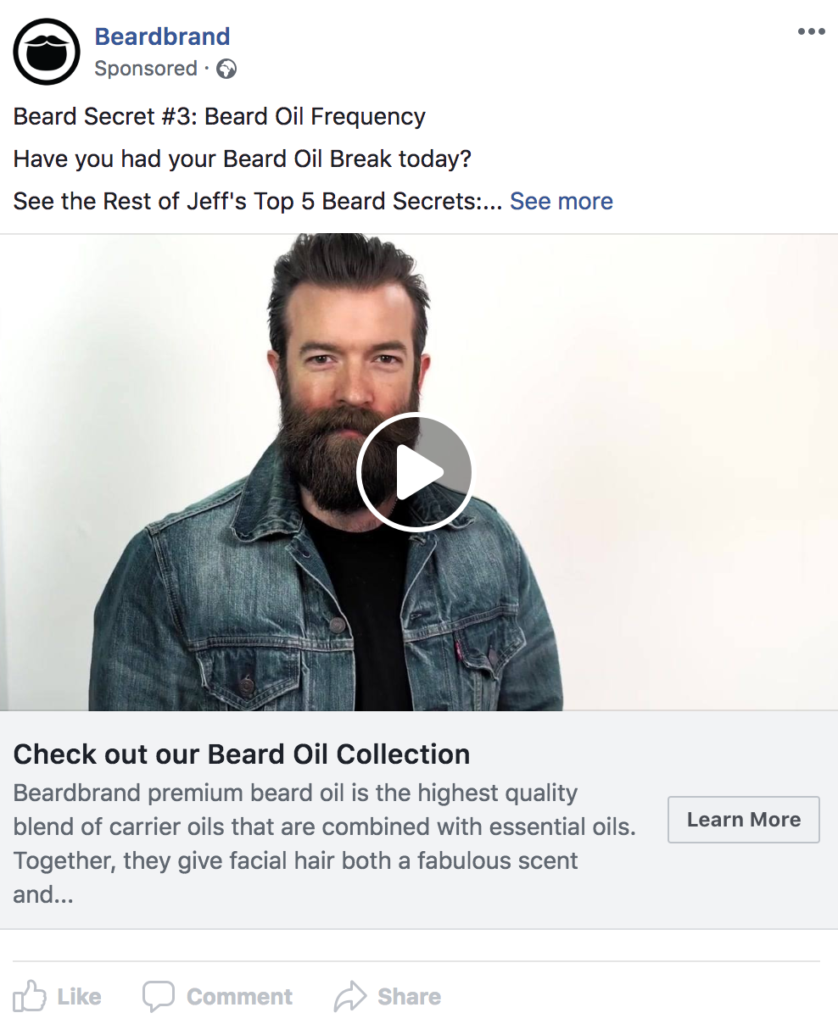
Let’s break down what they’re doing:
i. Preview content to drive more clicks.
The above video is a 23-second preview of a 5:33 minute and reveals only one of the five secrets promised in the headline.
If users are curious, they’re more likely to click through to YouTube to watch the video in full.
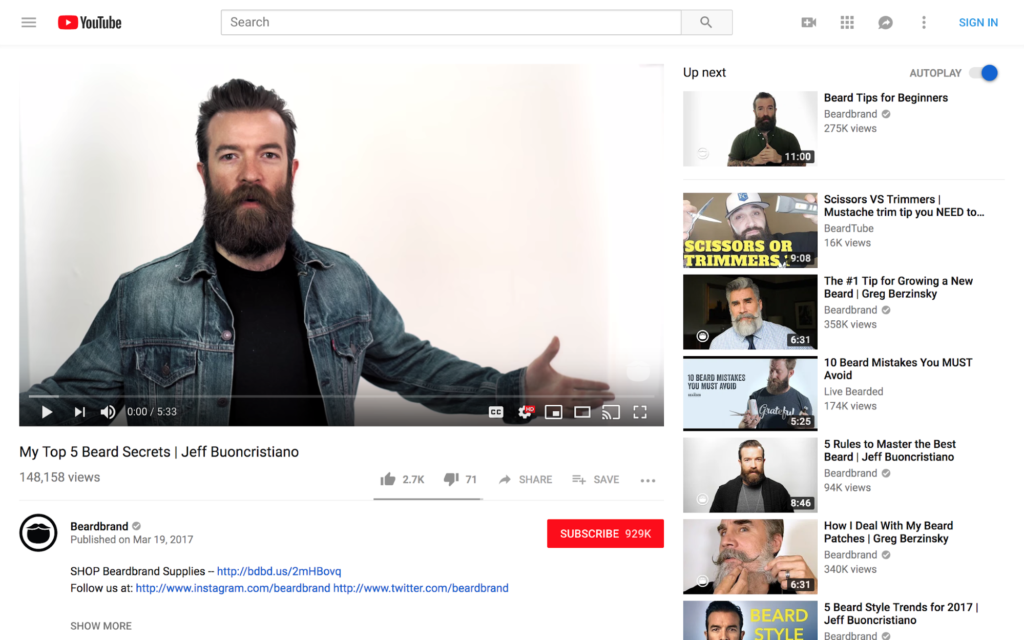
Then, if they’re ready to buy, they can click a link in the video description and buy from Beardbrand’s site.

ii. Using different calls to action for different users.
No two users are alike.
Some are at the decision stage of the buyer’s journey; they already like, know, and trust Beardbrand and are willing to buy again if reminded. They don’t need to click through to YouTube and watch a video; they need to click through to Beardbrand’s site and make a repeat purchase.
Others are at the awareness stage. They’re new to Beardbrand; they need to familiarize themselves with their brand before they buy from them. So, they click through to their YouTube channel to learn more.
Granted, you don’t have to use video. But it’s a great way to open a curiosity gap and drive more users to your content.
Action item. Use Facebook ads to drive traffic to your most popular content. Then, remarket to anyone that didn’t place an order or join your newsletter.
Strategy #9: Answer Frequently Asked Questions to Overcome Objections
One of Beardbrand’s most popular MoFu keywords is “styling balm vs utility balm.”
And for obvious reasons, Beardbrand has a LOT of content around answering that question.
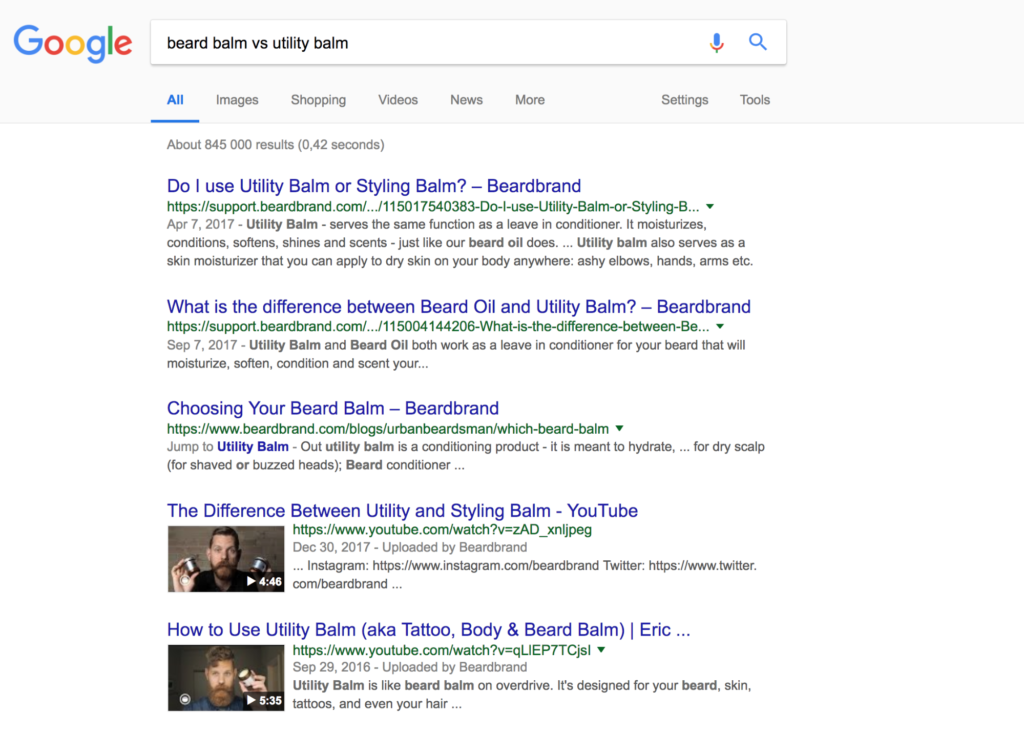
It’s no surprise, then, that they also answer that question in their Facebook ads.
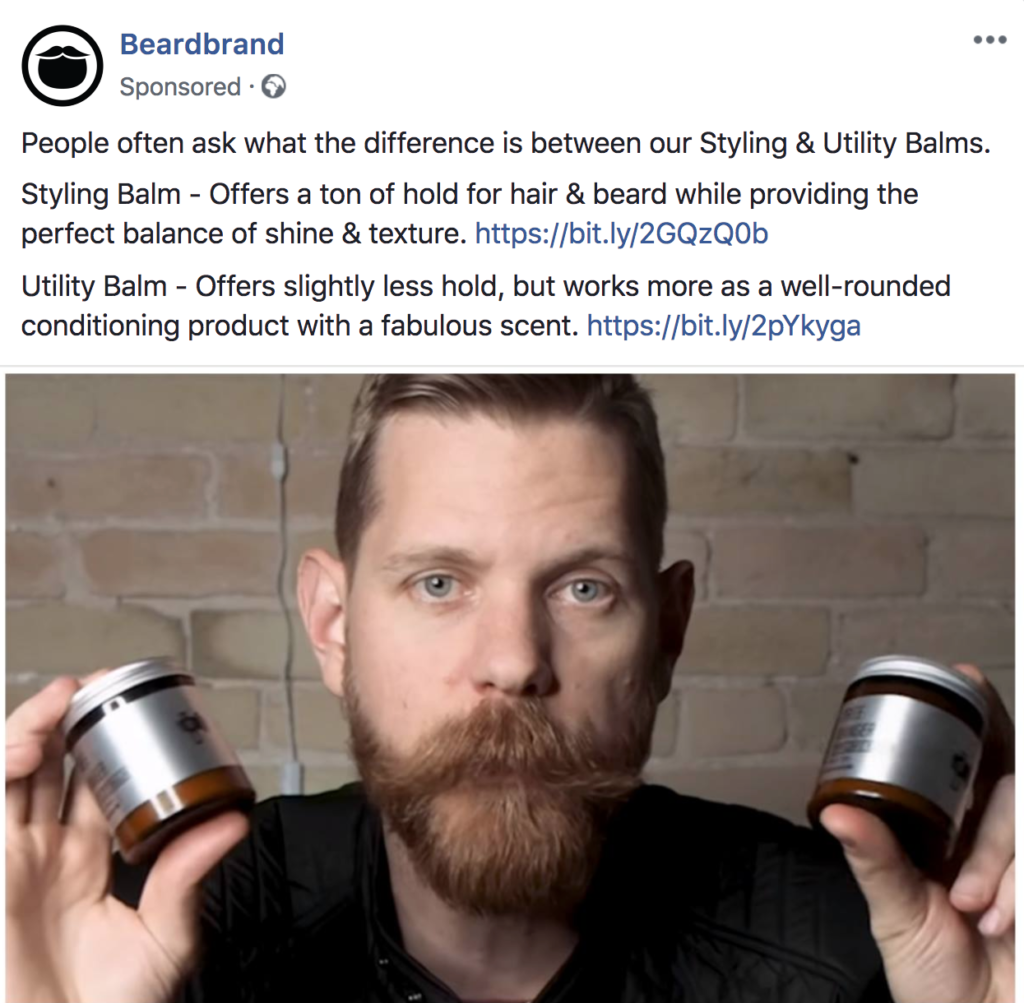
Answering frequently asked questions is a great way to overcome buyer objections. Beardbrand knows decision-making can paralyze prospects; given a difficult choice, they’re unlikely to buy.
So, they take two of their bestselling items and compare them side-by-side to help prospects decide which, if any, is right for them. And if neither is a good fit? There’s an opportunity to get their email address, provided they visit their site, of course.
But that’s not all…
As of writing, they’re also testing their ad copy and design assets to see which converts better. Here’s a variation of the above ad with longer copy and a video:
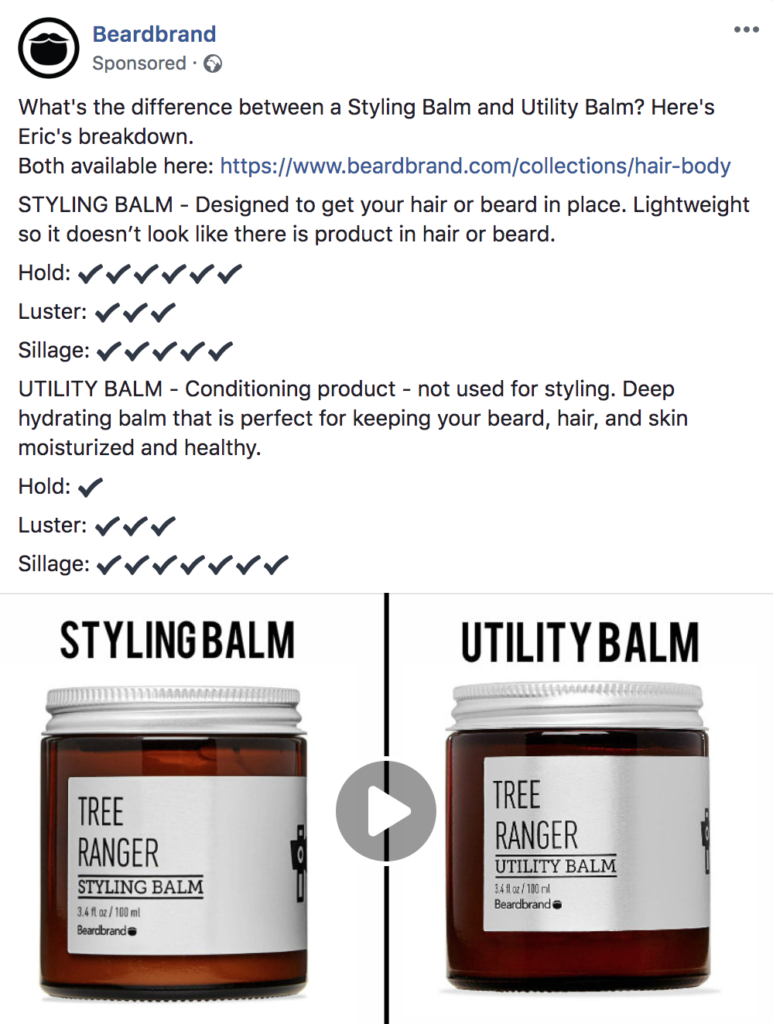
While it’s impossible to know how well the above ads are converting, we can assume that they’re driving sales.
And it’s not hard to see why.
Action item. Answer frequently asked questions about your bestselling products using Facebook Ads. Then, continue to optimize your ads based on their performance.
Strategy #10: Improve Your Facebook Carousel Ads with This Little-Known Testimonial Hack
In case you’re unfamiliar, a carousel ad is an ad that allows you to showcase up to ten images or videos within a single ad, each with its own link.
Carousel ads are popular with online stores for an obvious reason:
The more choice you offer prospects, the higher the likelihood they are to buy (within reason, of course).
In fact, according to one report, carousel ads are 10 times better at getting people to click through compared to static sponsored posts on Facebook.
Oftentimes, a brand will add the product’s name to the description like this ThinkGeek example:
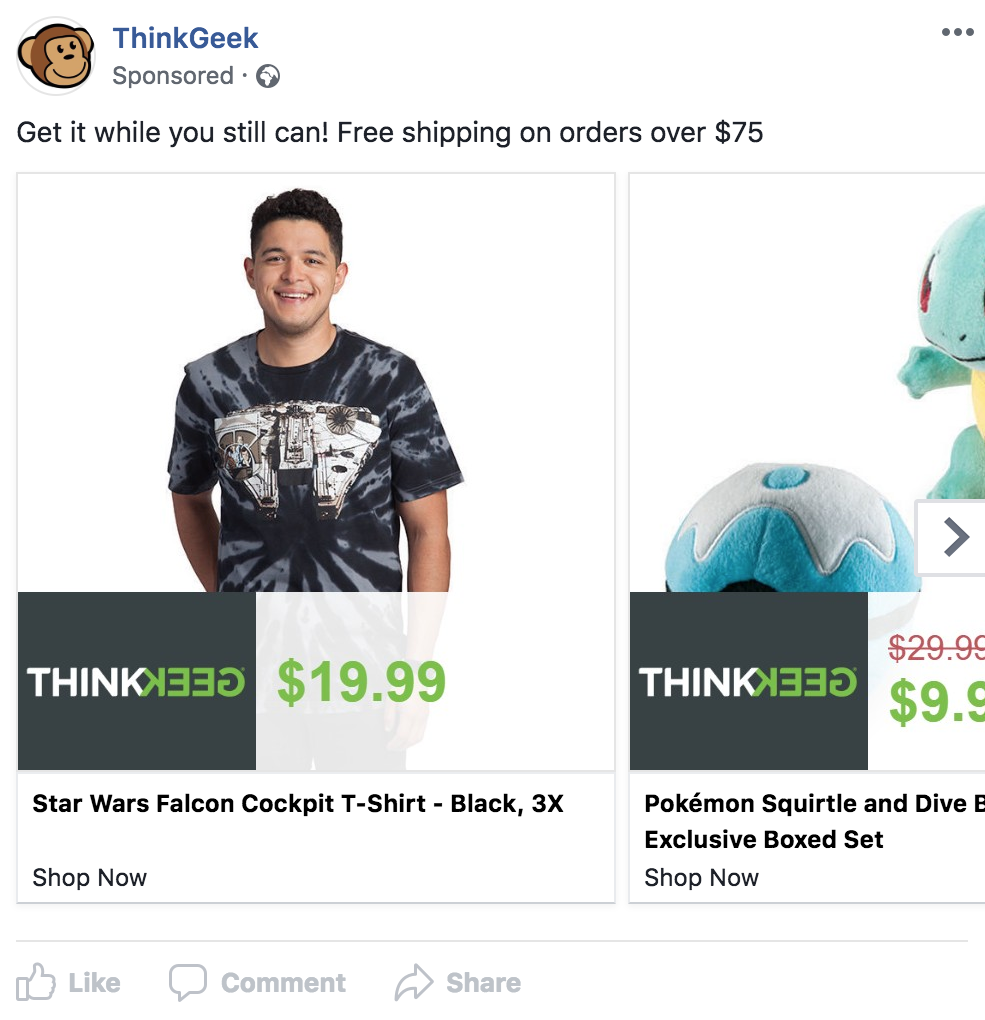
But not Beardbrand.
They add customer testimonials to the headlines of their products.
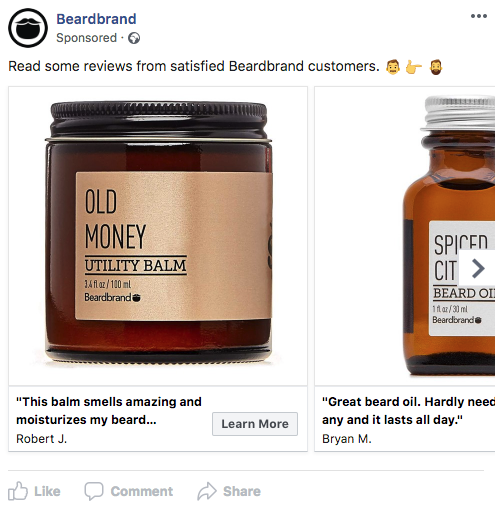
But they don’t just add any reviews.
They add reviews that overcome potential buyer objections.
For instance, in the first review, Robert addresses its smell (“What if it doesn’t smell nice?”). In the second, Bryan addresses its longevity (“Will I need to buy it often?”)
Few are doing this. And if you’re not, now’s the time to start.
Action item. Use customer reviews in place of product names when using Facebook carousel ads.
Part 5. Email Marketing
Like many online brands, Beardbrand sends a variety of marketing emails. (In fact, while researching this post, it was hard to know which emails to focus on.)
Below, I’ll focus on three specific email marketing strategies they’re using to increase engagement, recover abandoned carts, and convert subscribers into customers.
Here we go…
Strategy #11: Turn Prospects into Customers with a Drip Email Course
Beardbrand uses a drip email course as their core lead magnet on their site. You can opt in for it through the sidebar on the blog page or in certain blog posts.
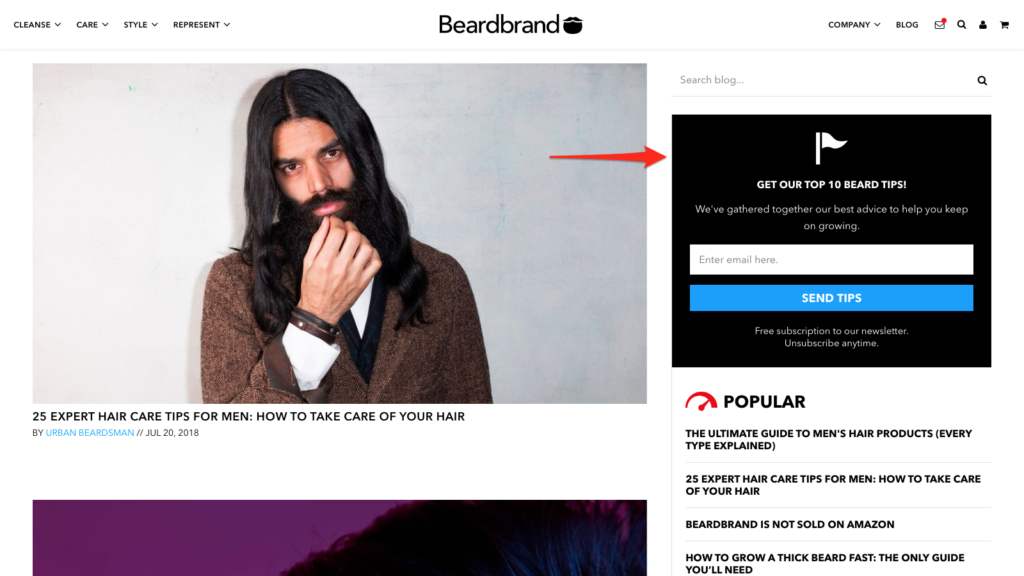
It’s 10 emails long, and each has a CTA to either (1) increase user engagement through linking to relevant content. Or (2) turn subscribers into customers.
While I won’t cover the content of each email, I will highlight a few interesting strategies they’re using.
i. Link to Recommended Products (When Relevant)
In Email #3, Bandholz goes deep into different aspects of beard grooming.
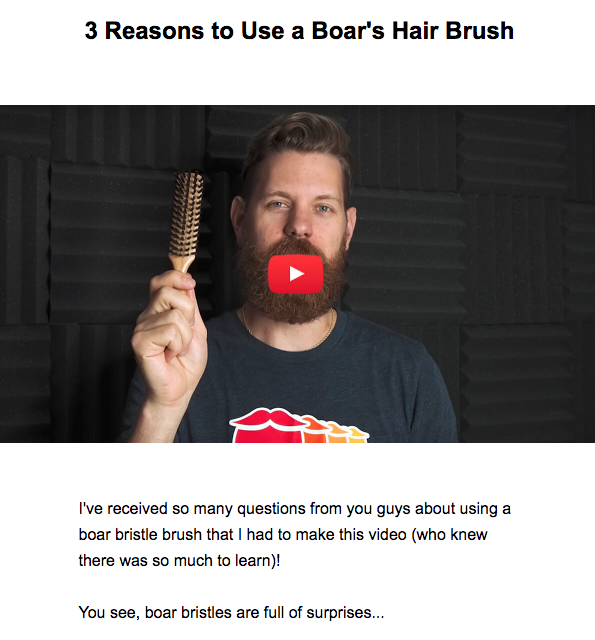
And in the footer, he links to their combs and brushes, and includes customer reviews for those products.
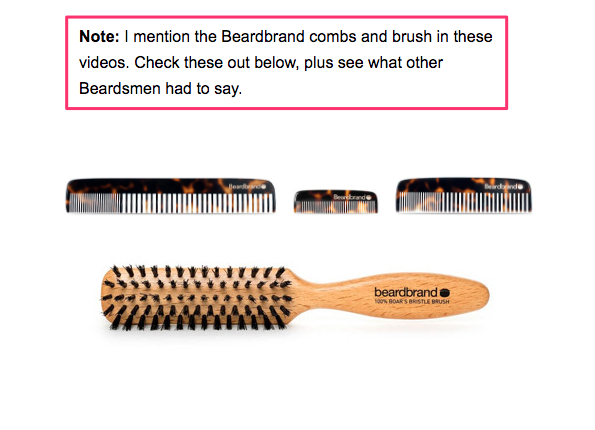
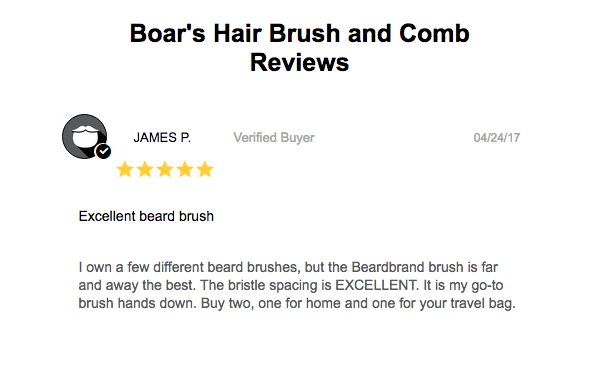
The above happens in several emails with other products and is an effective way of introducing their offer without being “salesy”.
ii. Offer a Reward Upon Completion
When you complete Beardbrand’s 10-day email course, they offer you a gift.
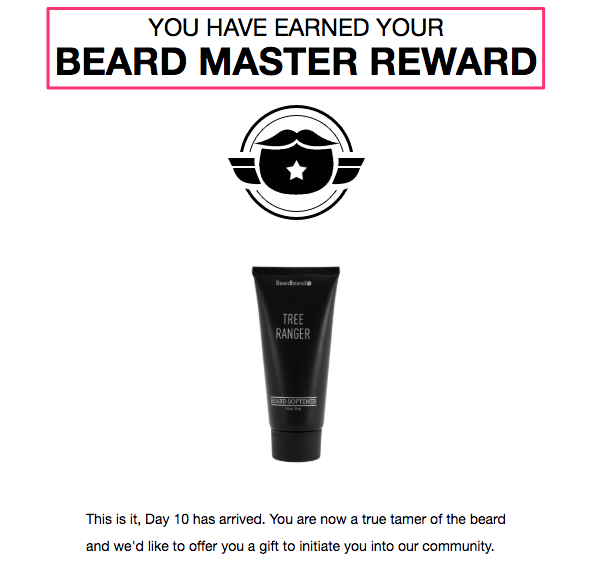
But there’s a catch:
You can only claim it if you buy something else.
What’s interesting is if you abandon your cart before checking out, Beardbrand sends you a cart recovery email.
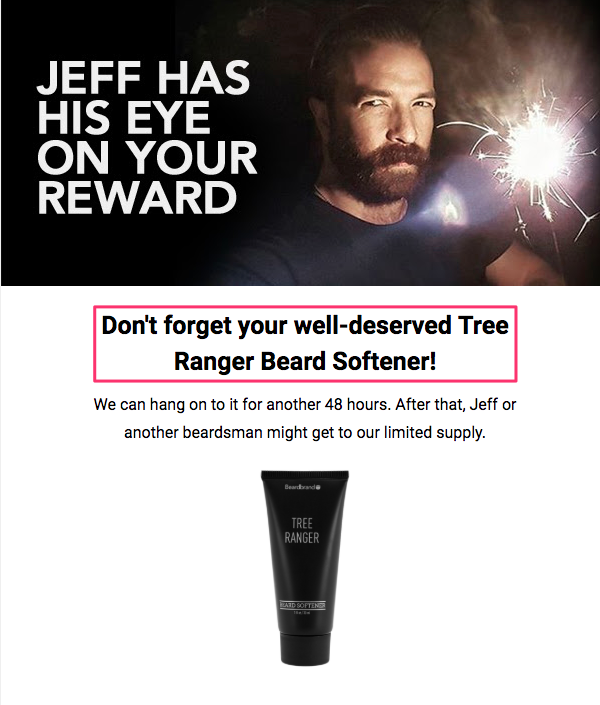
And it makes sense:
If you go back to their site to claim it, you’re far more likely to buy other items, too.
iii. Drive Users Back to Your Site
As mentioned before, Beardbrand has built a loyal YouTube following.
So, it would make sense to drive new subscribers to their channel, right?
Not exactly.
One thing Beardbrand does with each email is drive users back to their site. But not just to their site, but to a blog post with a relevant YouTube video embedded.
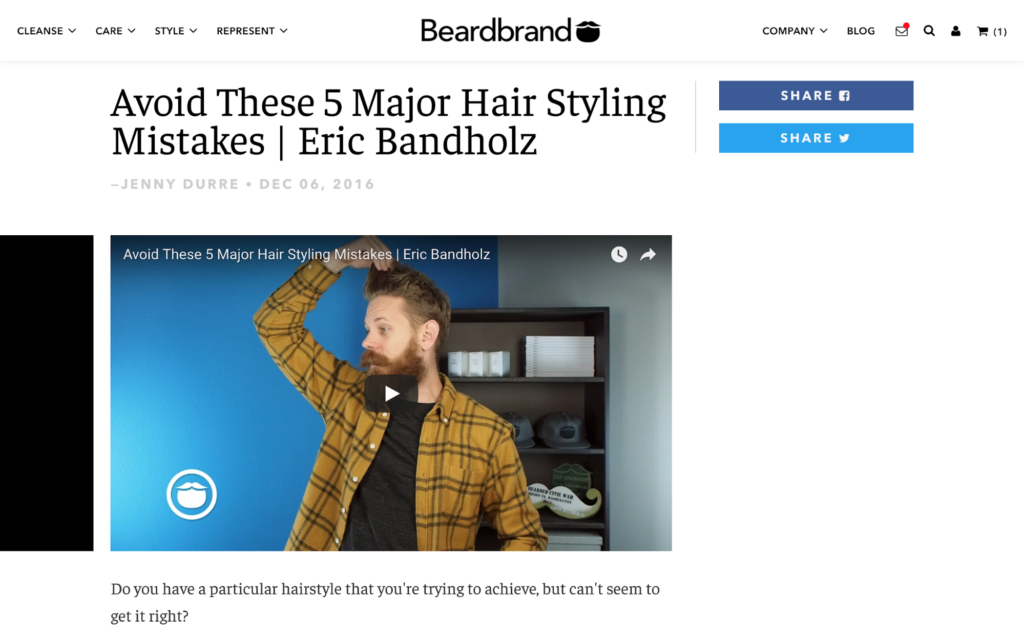
It’s subtle, but there are a few reasons why they might be doing it.
- Increase dwell time. As mentioned before, it’s no secret that increasing dwell time helps improve rankings in the SERPs. And adding videos to content is an effective way to keep users on-site longer.
- Reduce cart abandonment. See the item in my cart in the top right-hand corner? I forgot about that. That is until Beardbrand sent me back to their site, and I saw it.
- Improve lead scoring. If Beardbrand scores its leads based on user engagement, it’s easy to remarket to users that have clicked through from several emails to watch videos.
Action item. If you offer a lead magnet, consider using a drip email course. It’s an effective way of linking to relevant products and driving users back to your site.
Strategy #12: Cart Recovery + Facebook Retargeting = More Sales
Like many online stores, Beardbrand uses cart recovery emails in their email marketing.
But they use them in a way I haven’t seen before.
When I abandoned my cart (sorry, guys), I got the following email shortly after.
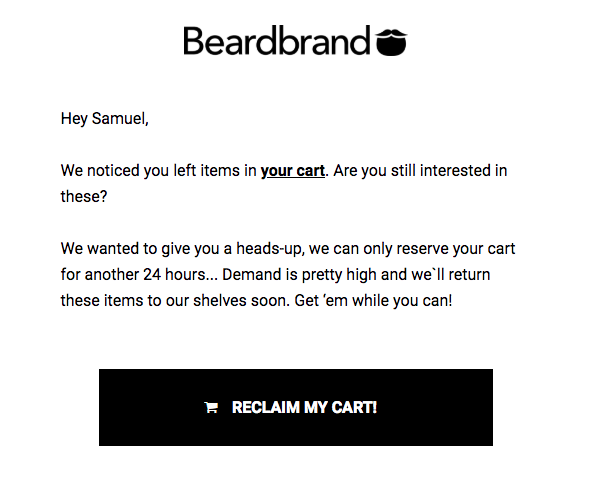
(Yes, Samuel. This is serious.)
Pretty standard, right?
I thought so, too.
That is until I browsed Facebook several hours later and saw this:
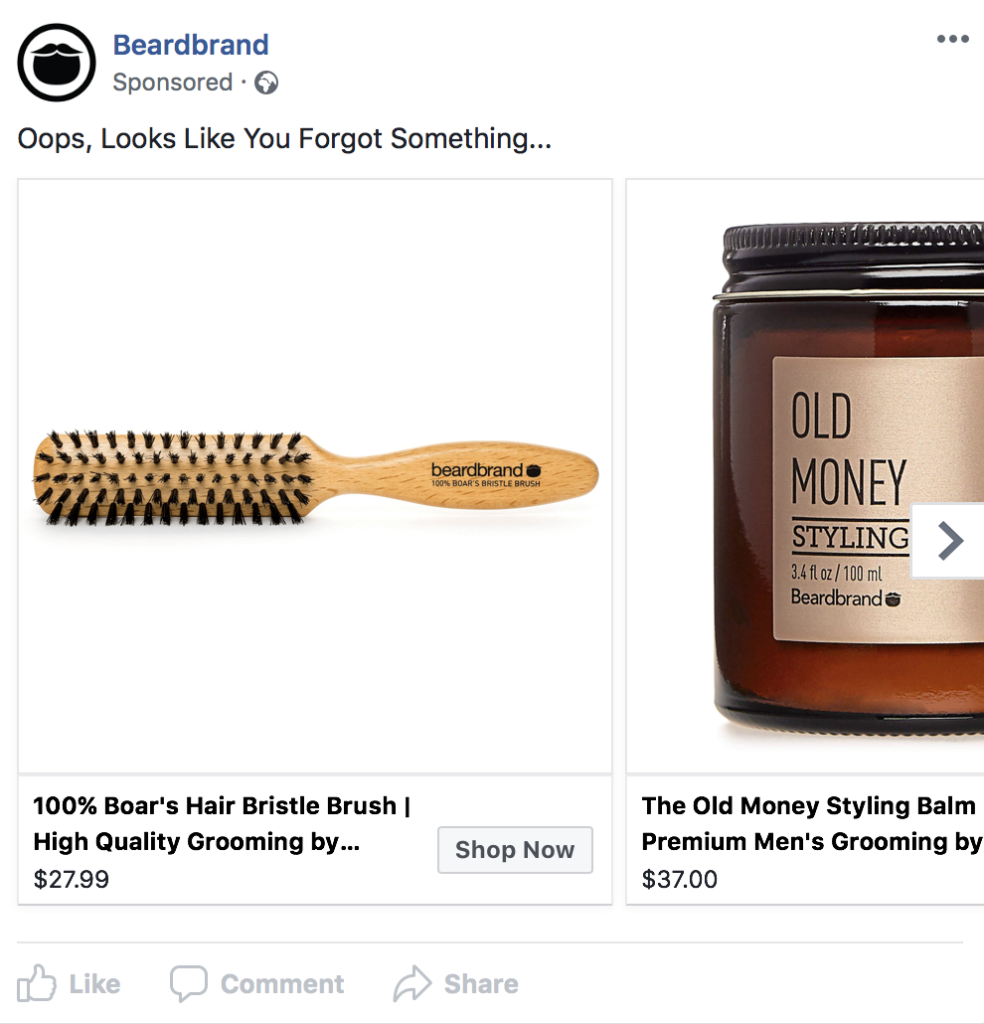
That’s right:
Beardbrand uses a cart recovery email AND a Facebook retargeting ad to close forgetful buyers.
And best of all, they use a carousel ad, meaning they have several ways to lure users back to their site.
Action item. Create a “catalog” on Facebook to generate dynamic ads for your products and show personalized recommendations to people who view your ad.
Strategy #13: The Best Use of a Lead Magnet I’ve Ever Seen
After a few weeks of going through Beardbrand’s email marketing funnel, I got this email:
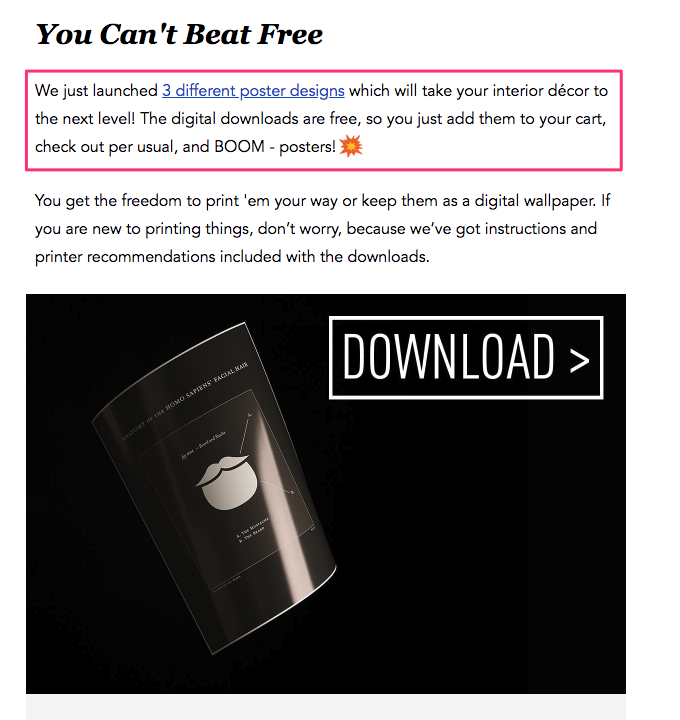
So, I clicked through to their site to download my free poster.
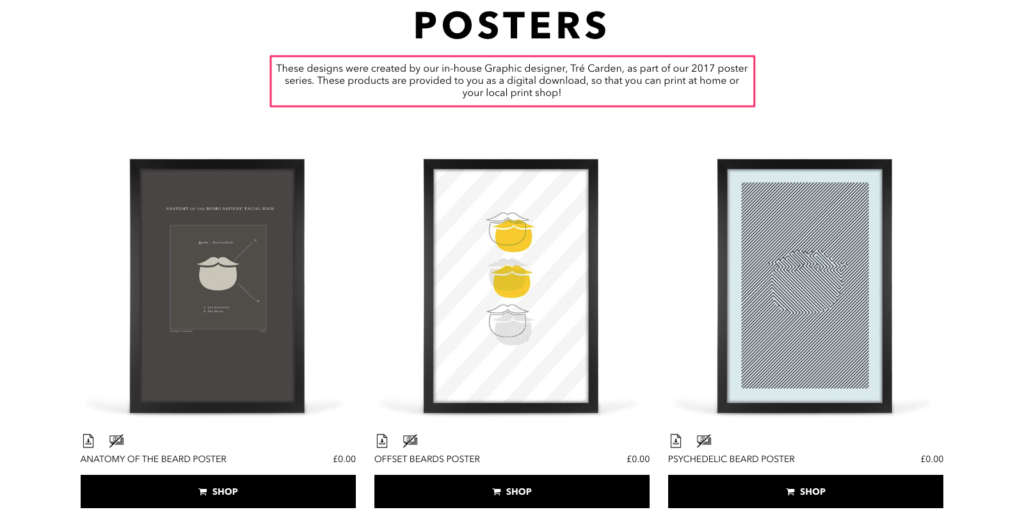
But when I clicked “Shop” to download my favorite, I noticed I had to “shop” for it, meaning I had to go through their checkout.
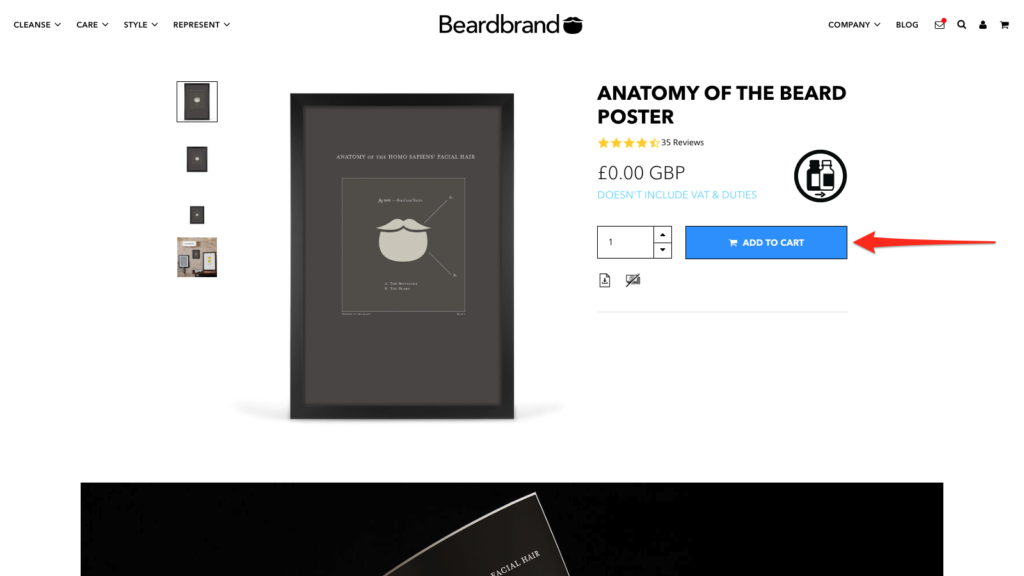
So, I added it to my cart and noticed something interesting. See if you notice it…
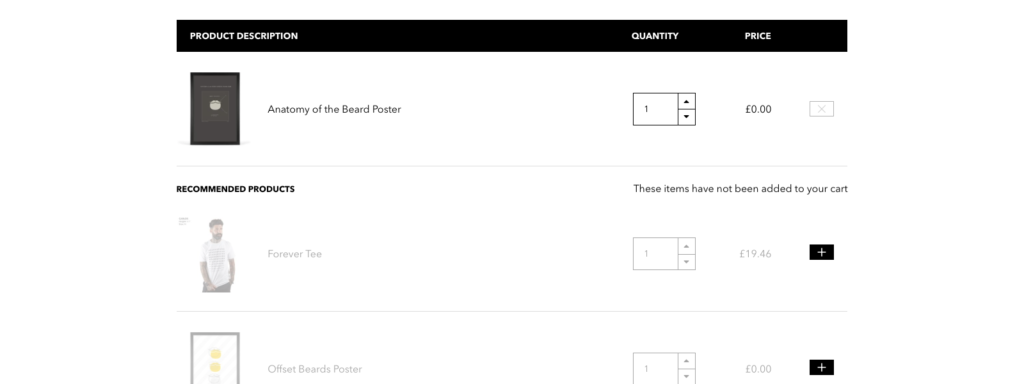
That’s right:
They recommended similar products.
But not just any recommended products: PAID recommended products.
In-between the free poster you’re “ordering” and another poster is a low-priced t-shirt.
In fact, they even do it once more in the confirmation email after checking out. (Yes, they send a confirmation email for a free item.)
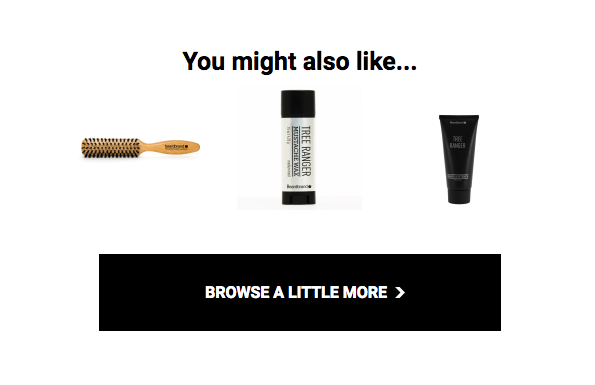
It’s smart to offer paid products with free products, but it doesn’t end there.
You have to add your shipping information.
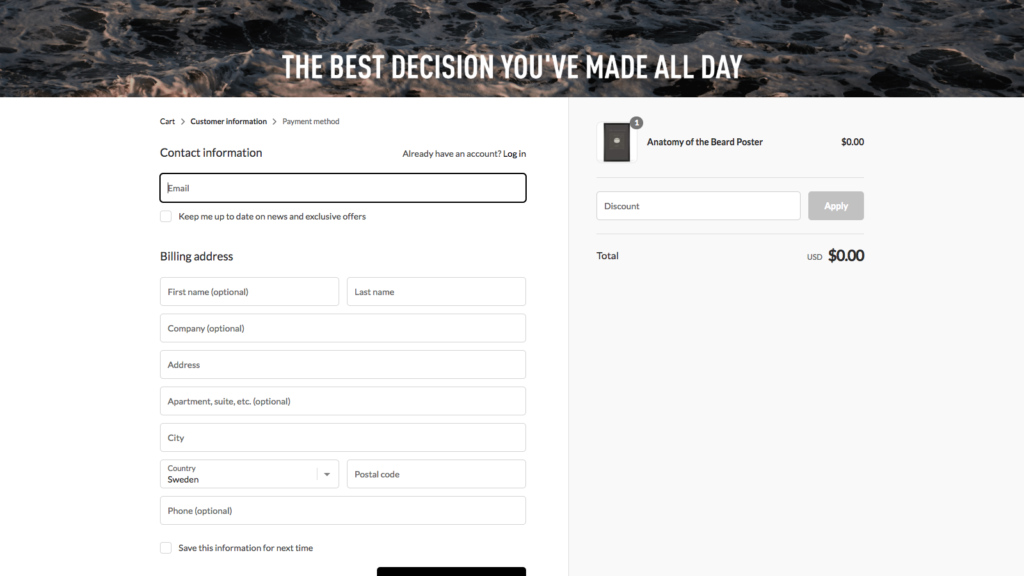
It’s smart because it allows Beardbrand to:
- Add new users to their newsletter. Rather than assume visitors came from their newsletter, Beardbrand gives users who came through a referral or another channel a chance to join their email list.
- Reduce cart abandonment. I know: why would Beardbrand need your shipping information to send you a digital download? I thought so, too. Until I thought about it and realized there’s a checkbox to grant them permission to save your information for next time … making it quick and easy for you to check out, if/when you become a future customer.
- Validate potential new markets. It’s likely brands like Beardbrand analyze its demographic data to determine new geographic locations to market to. Having this type of information on hand makes it a LOT easier for them to do so.
It’s a great strategy, and it must be working, as they’re also driving paid traffic to it.
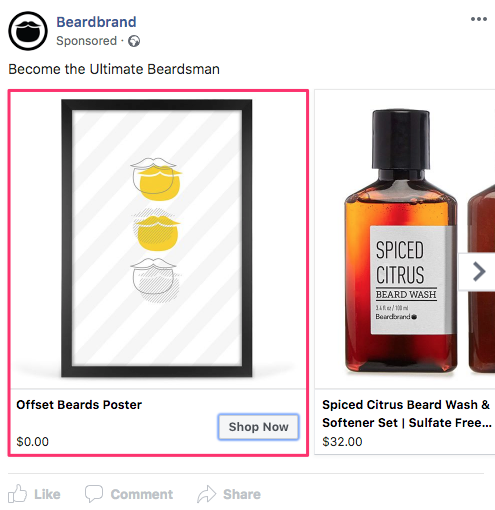
My favorite part?
If you don’t check out, you get not one but two cart recovery emails. (Yes, even for a poster.)
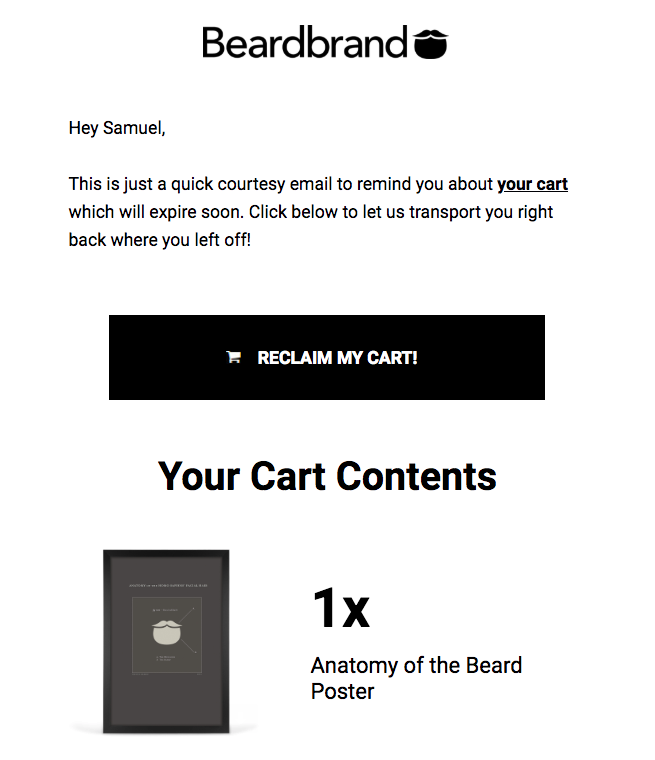
Driving users back to their site gives them a greater chance to upsell them. Or remarket to them later.
As the old adage goes, if it works, do more of it.
Action item. Rather than offer freebies through a link, invite users to go-through checkout to capture more information. Then, offer recommended products to turn them into customers.

Conclusion
I’ve written a lot about Beardbrand’s marketing.
And I hope you’ve learned a lot. (I know I have).
Now it's your turn to take what you've learned here and apply it to your business.
Good luck!



